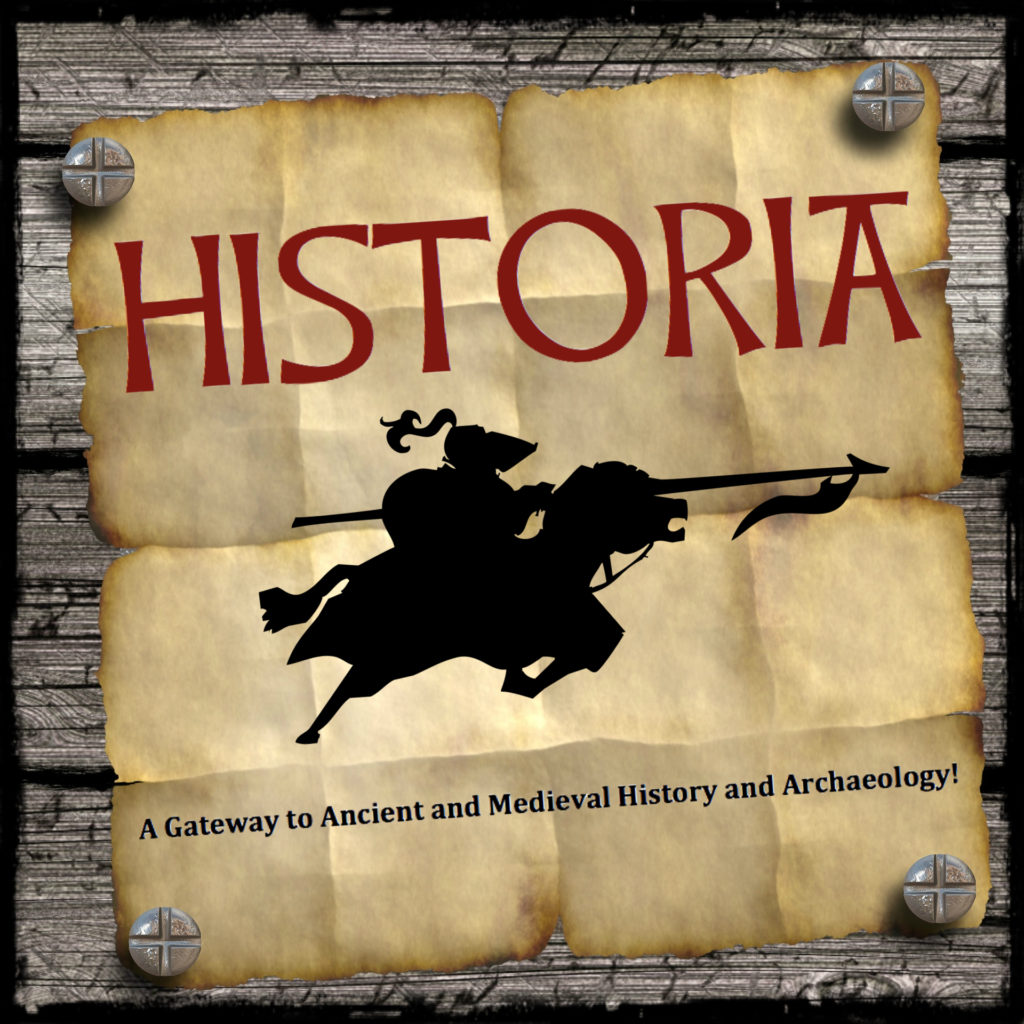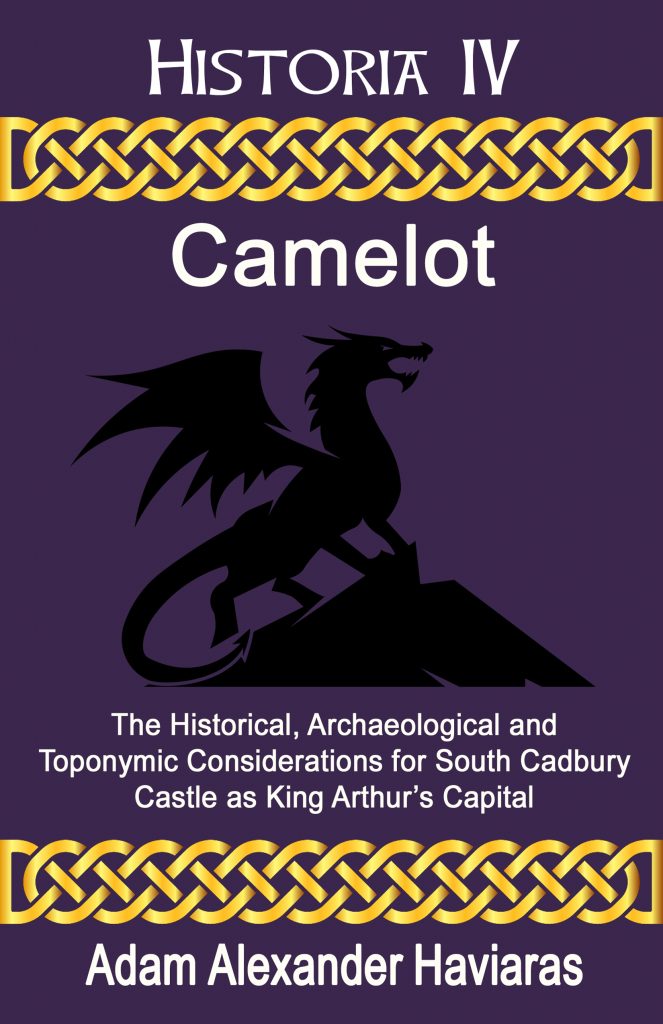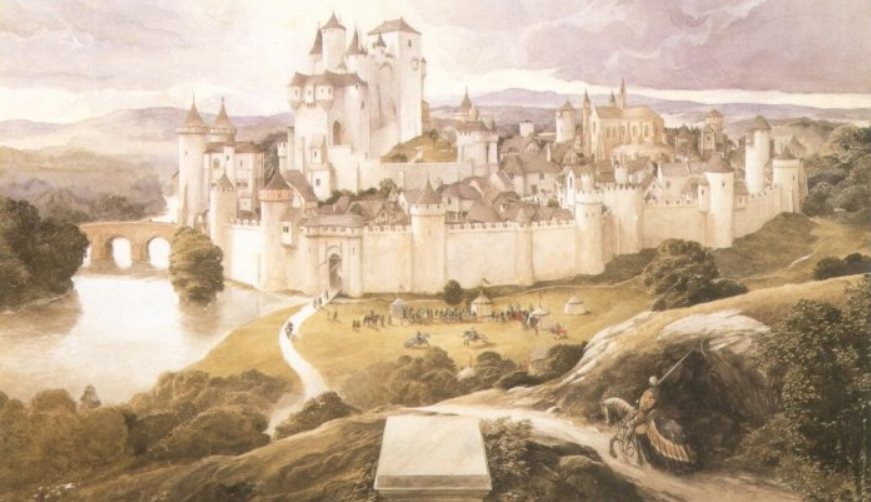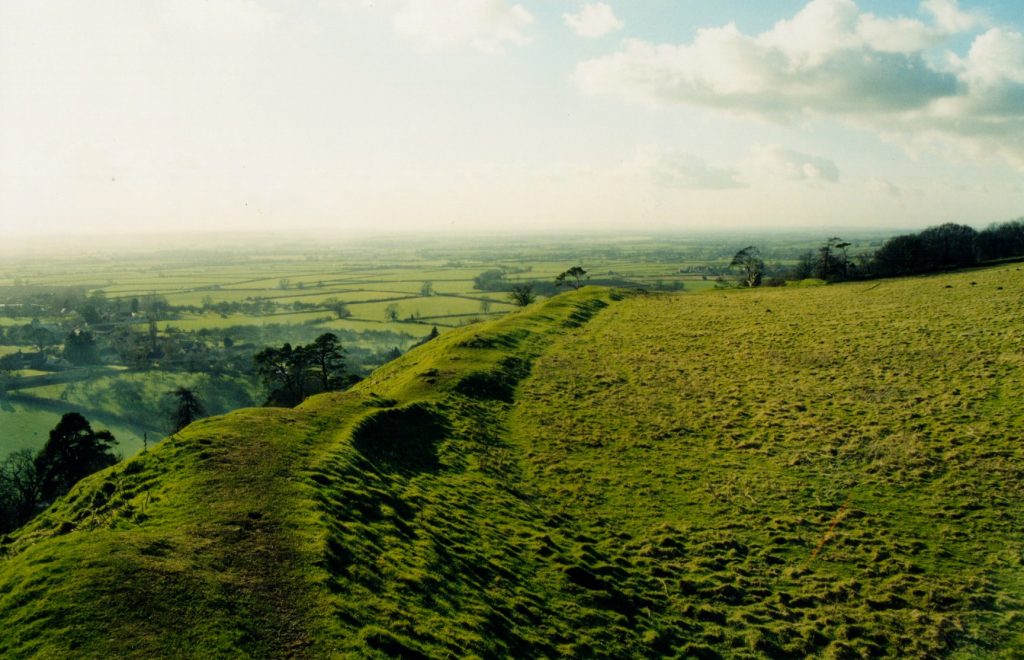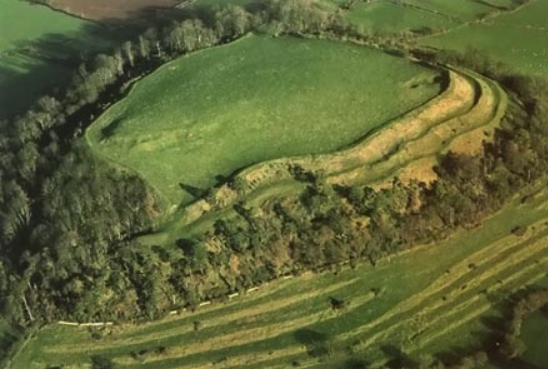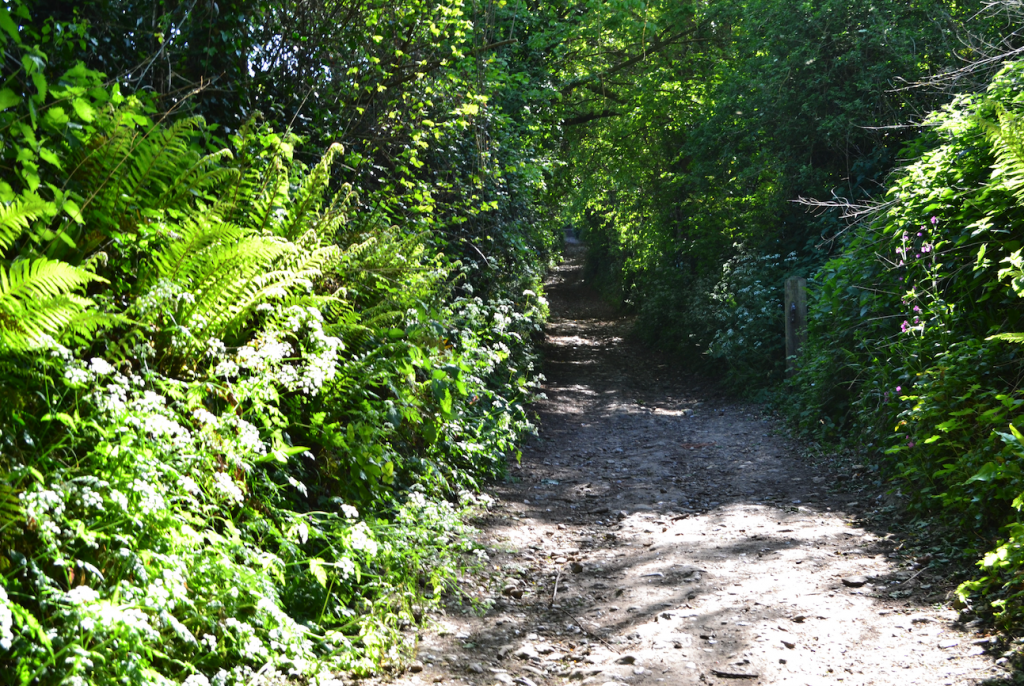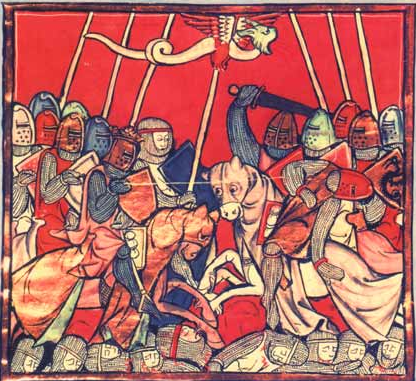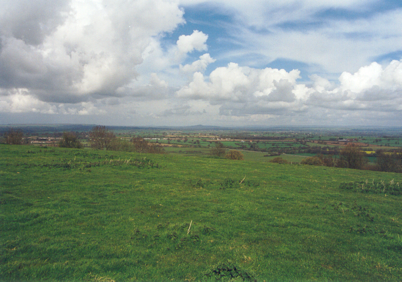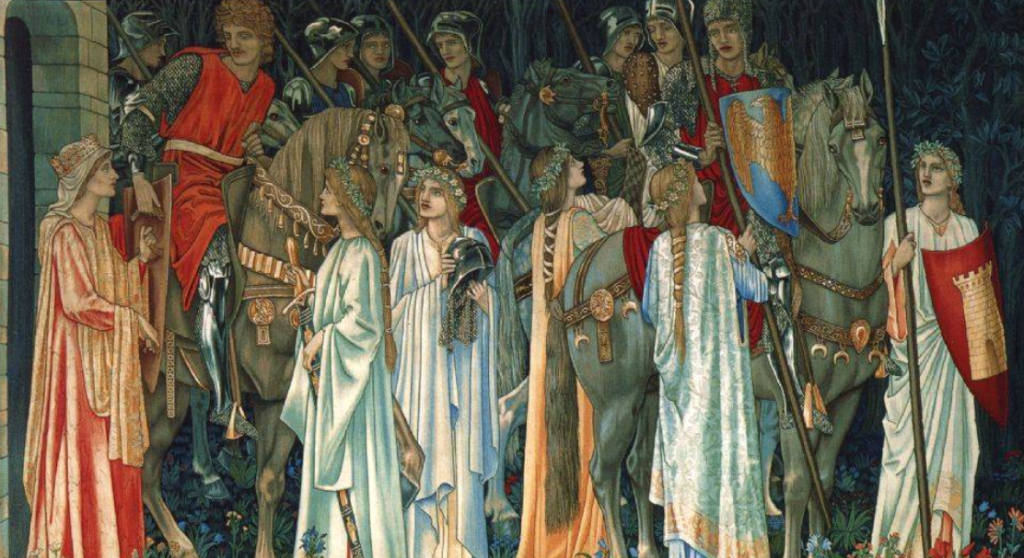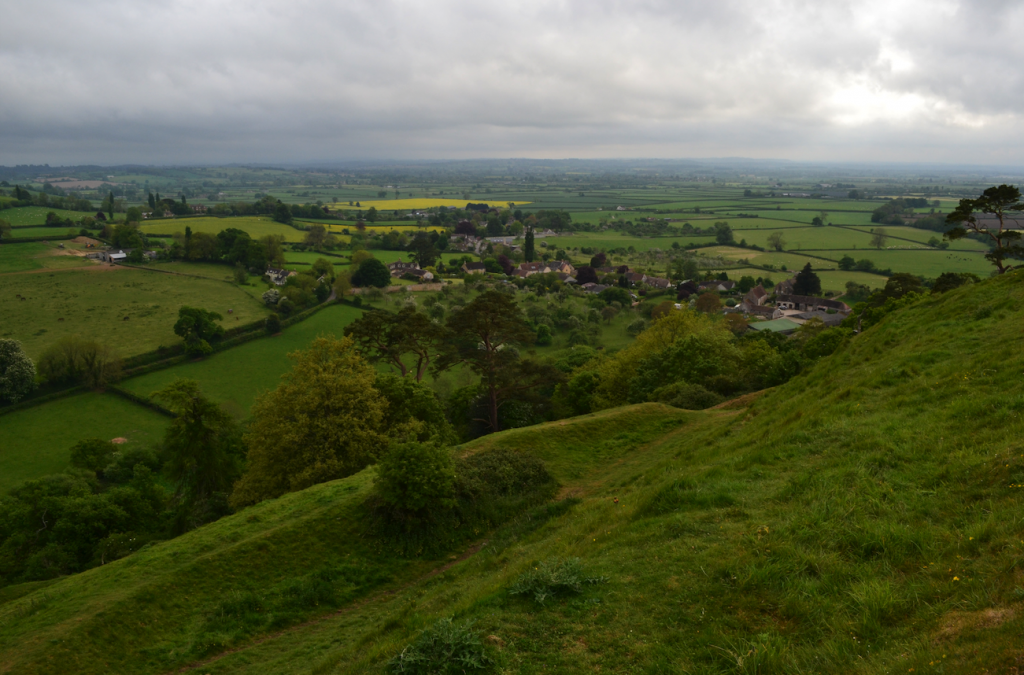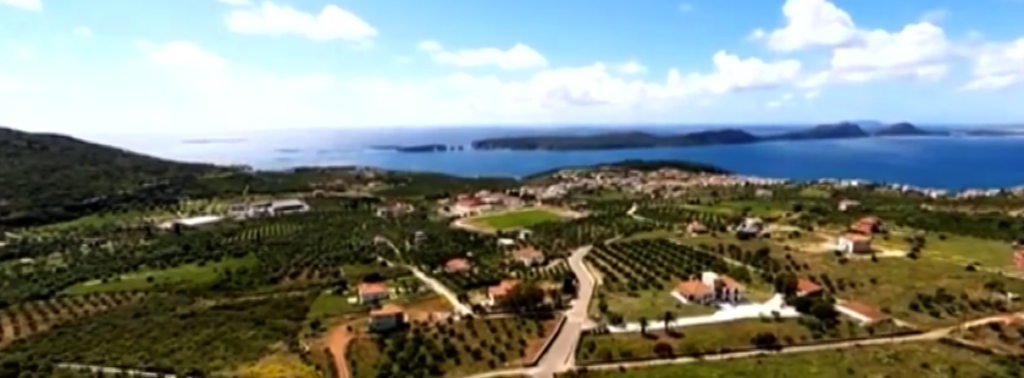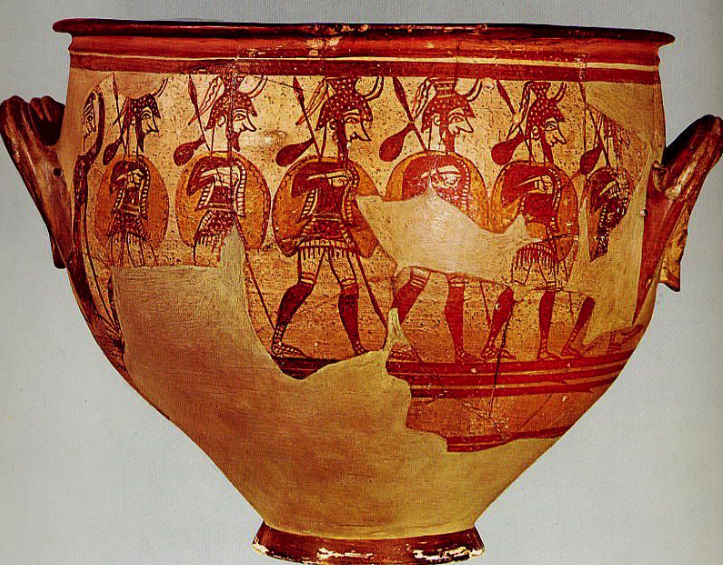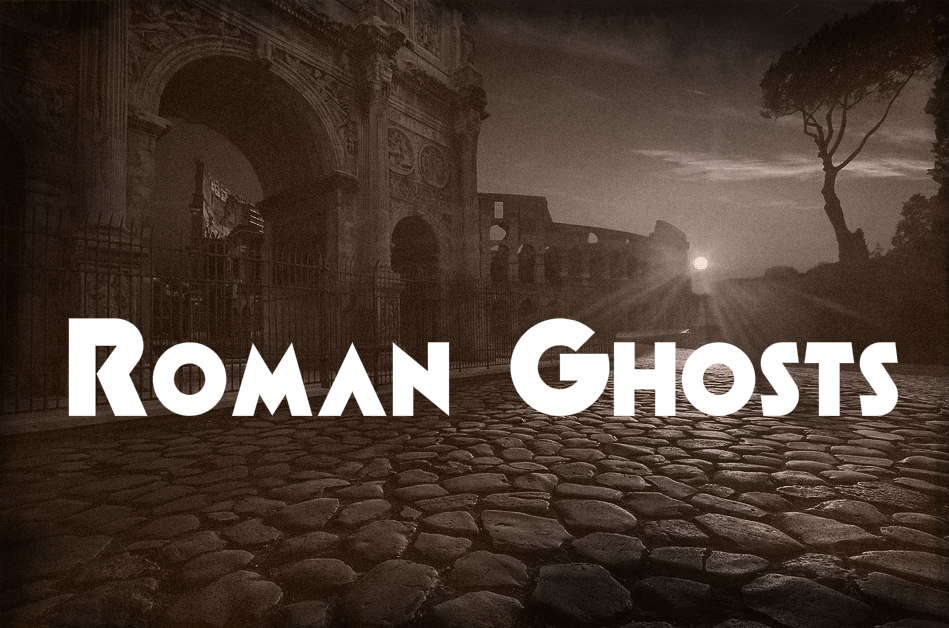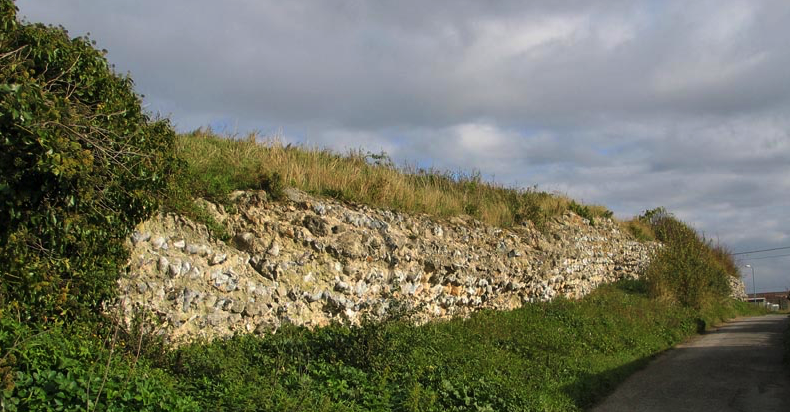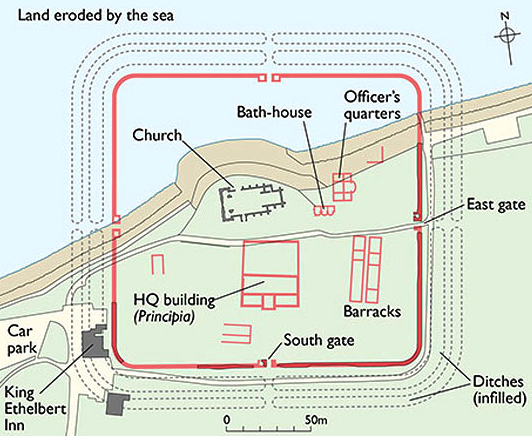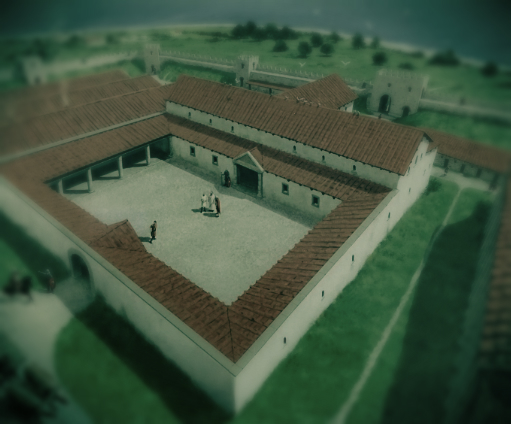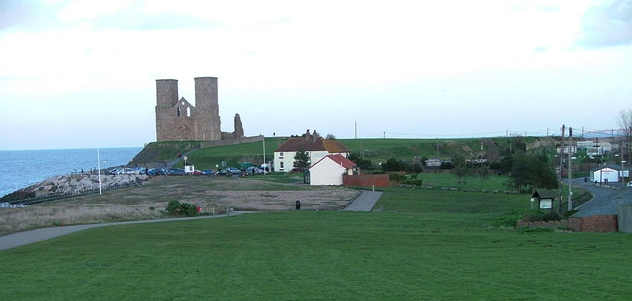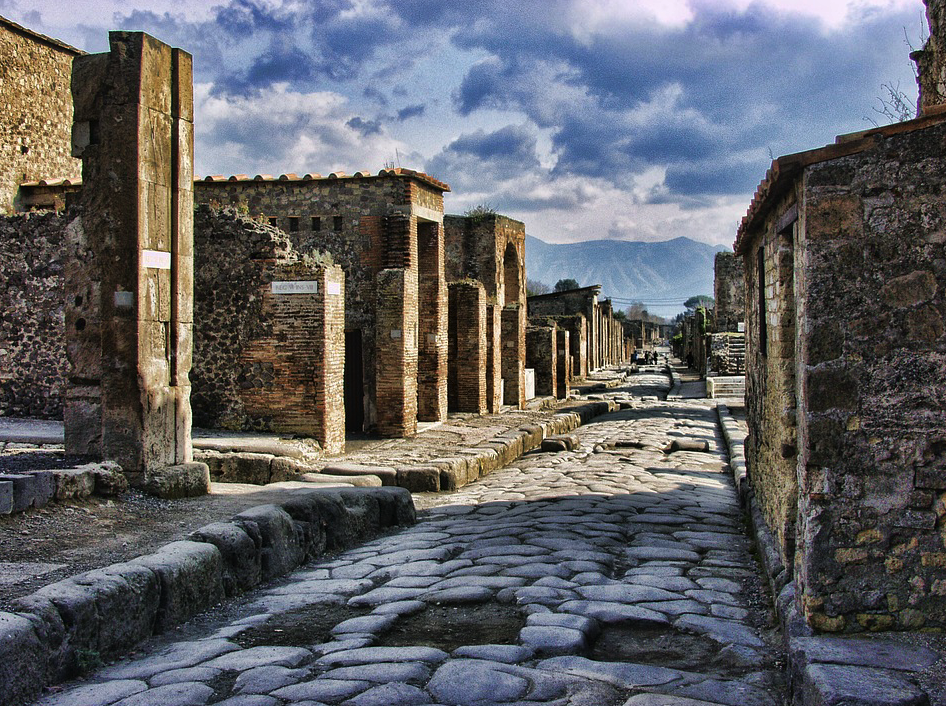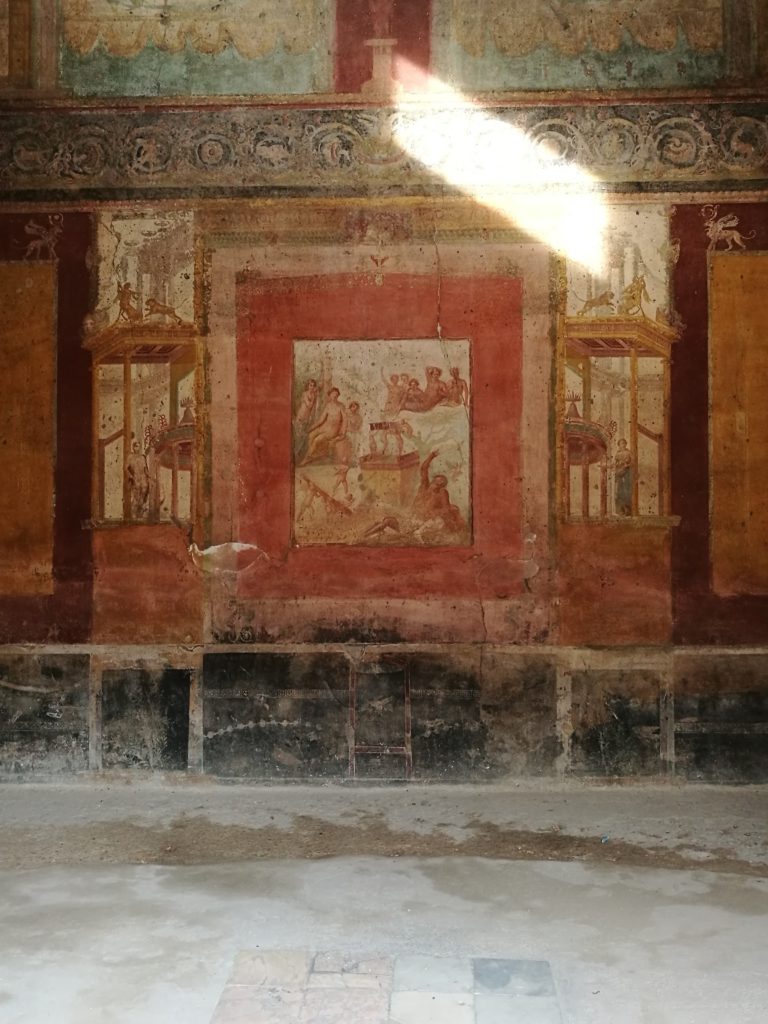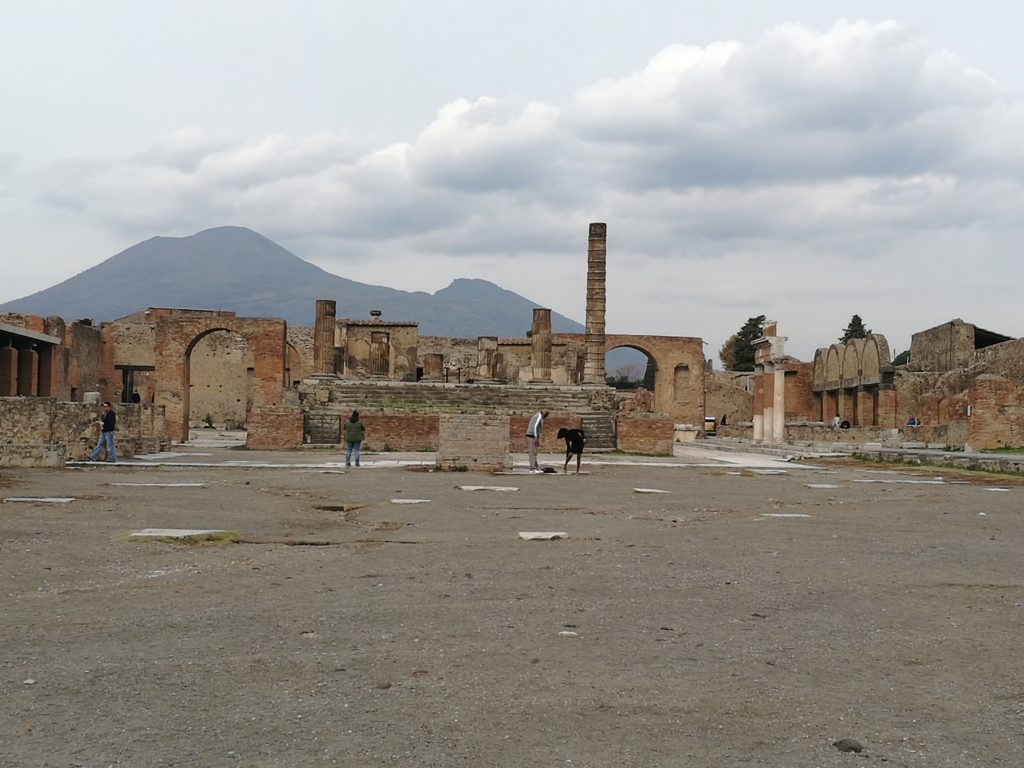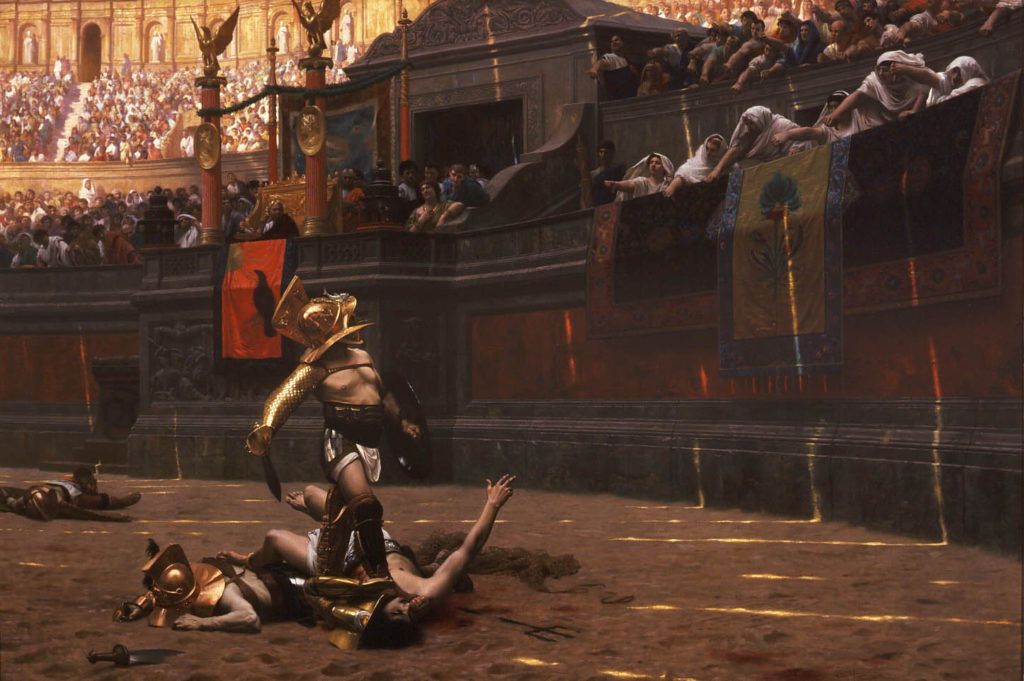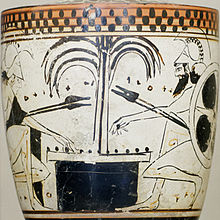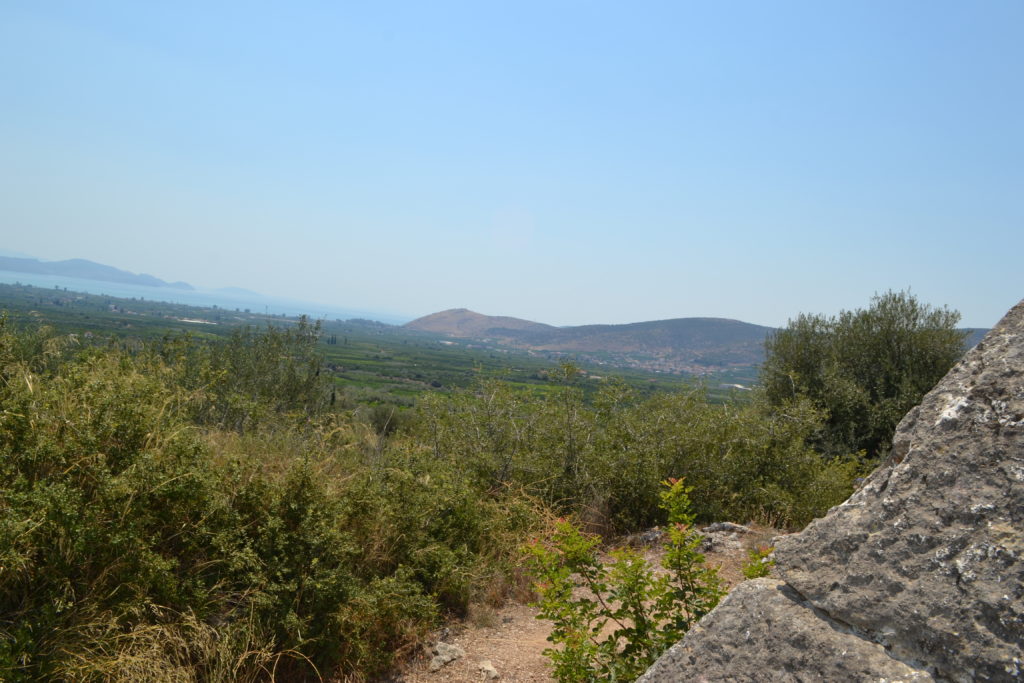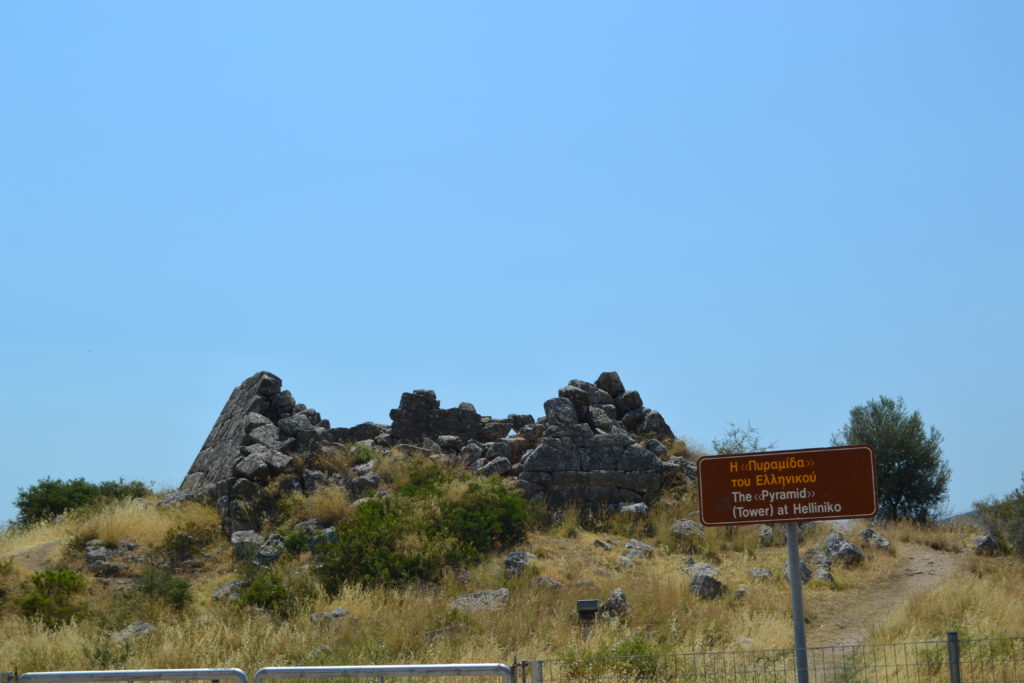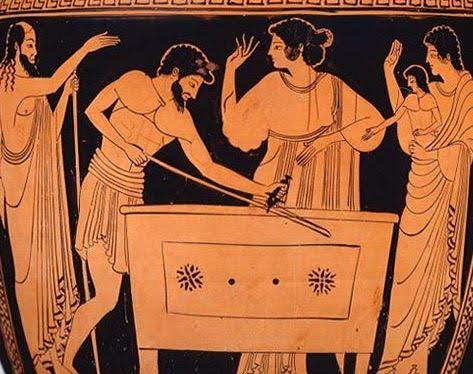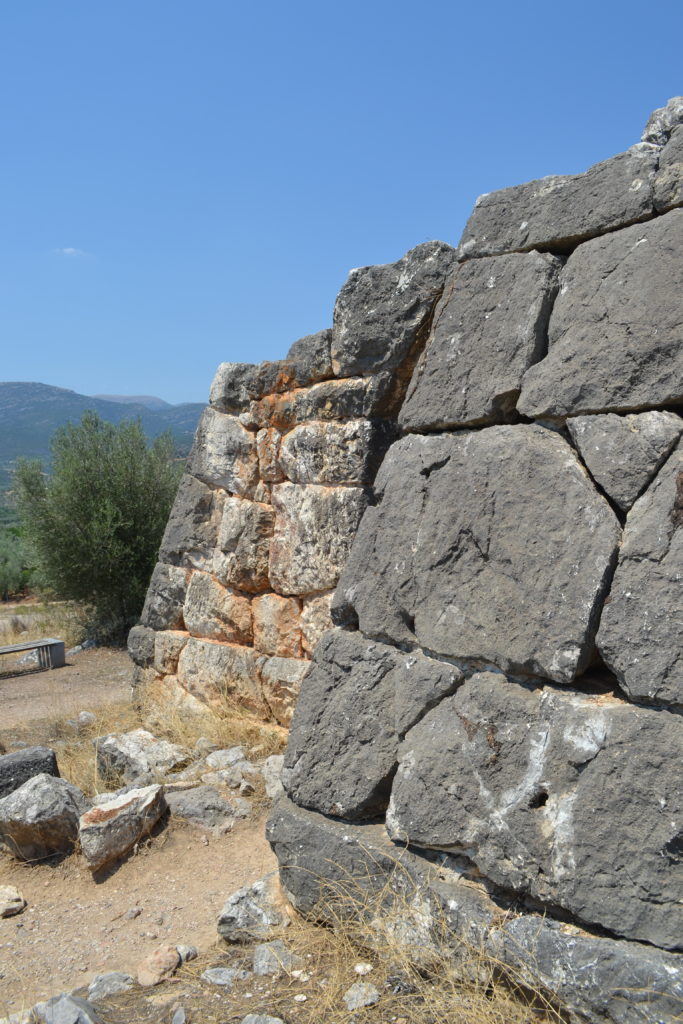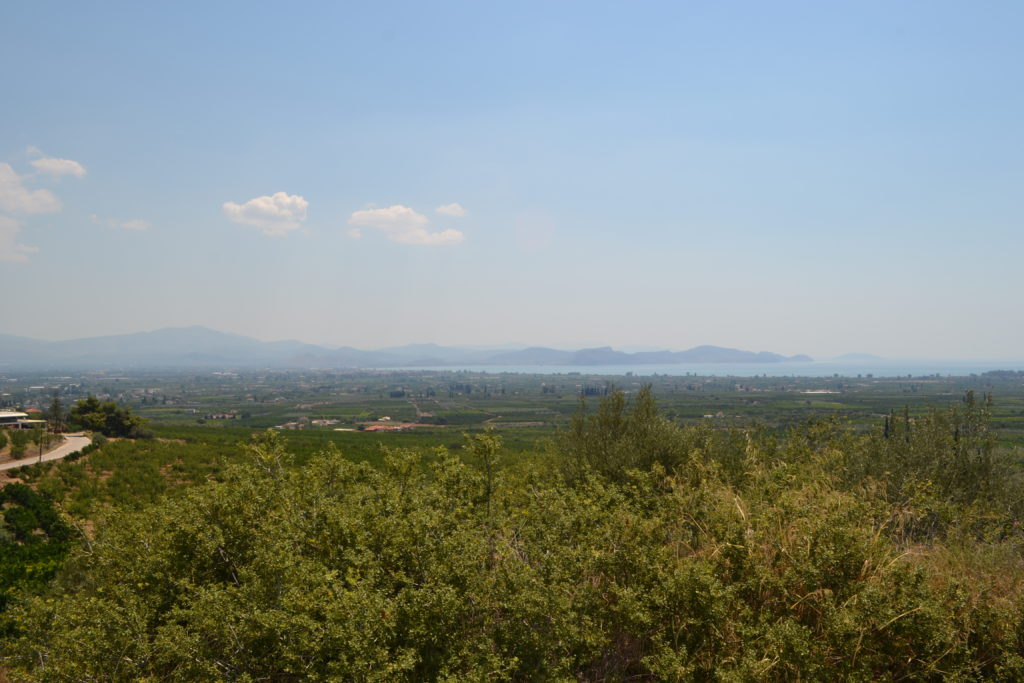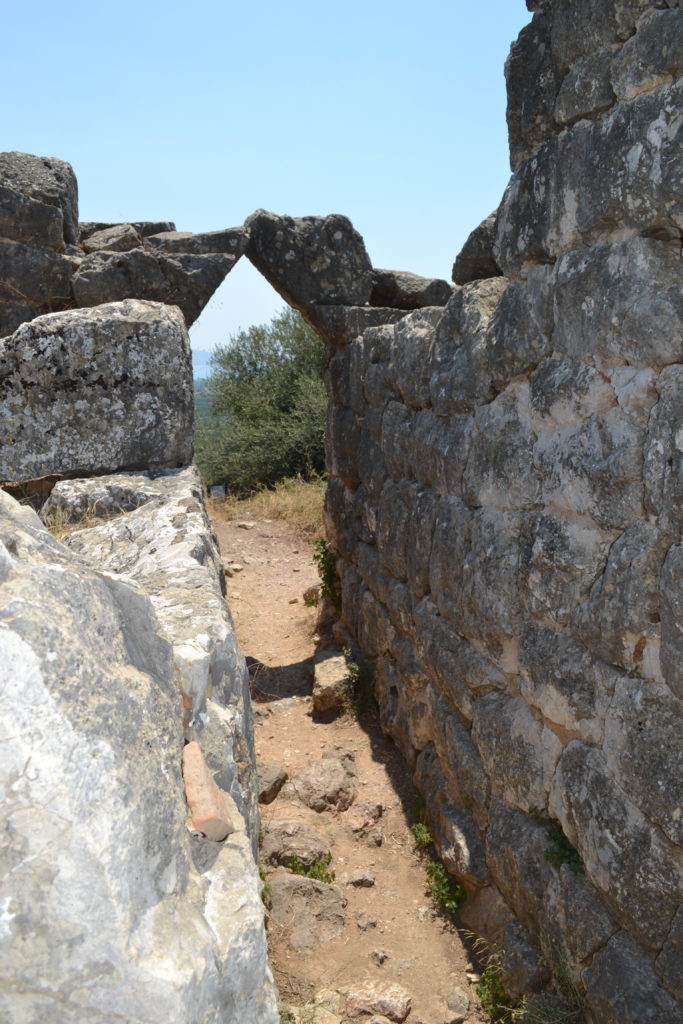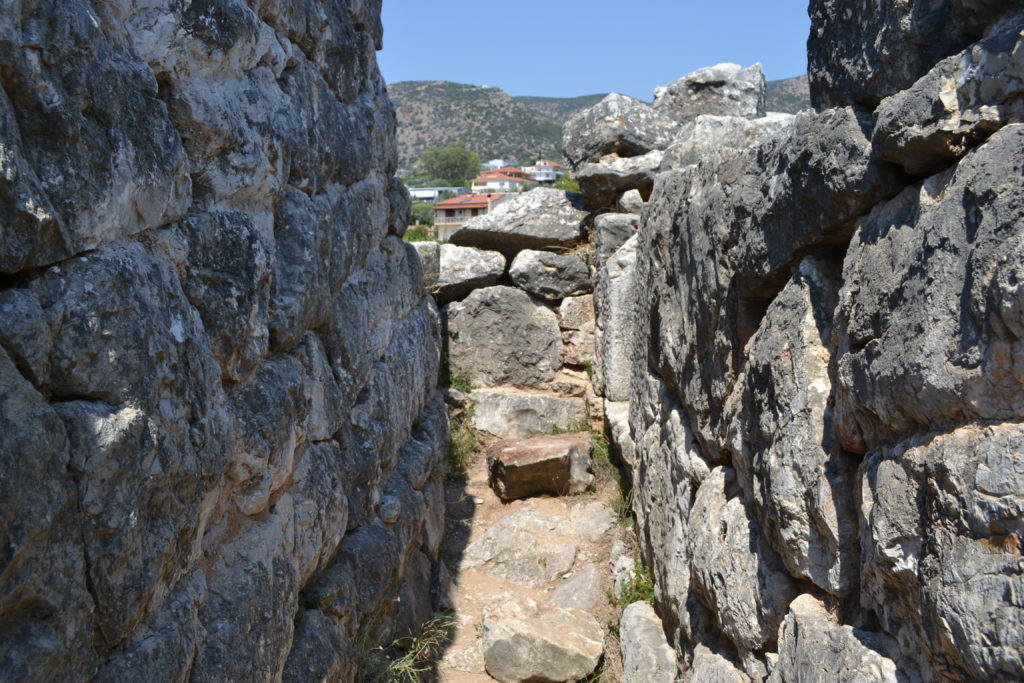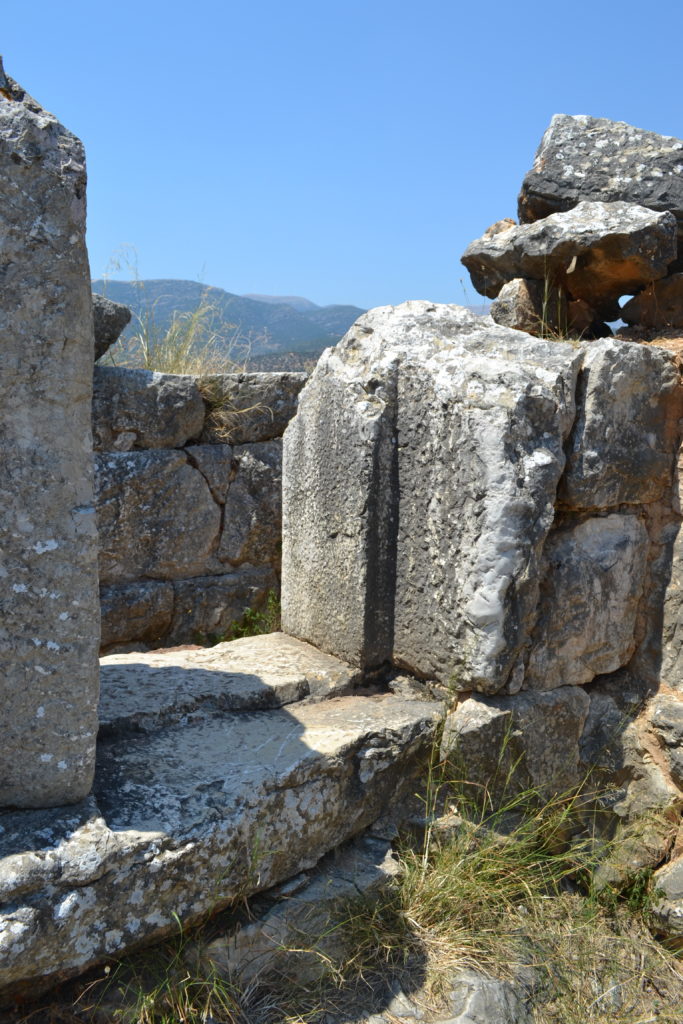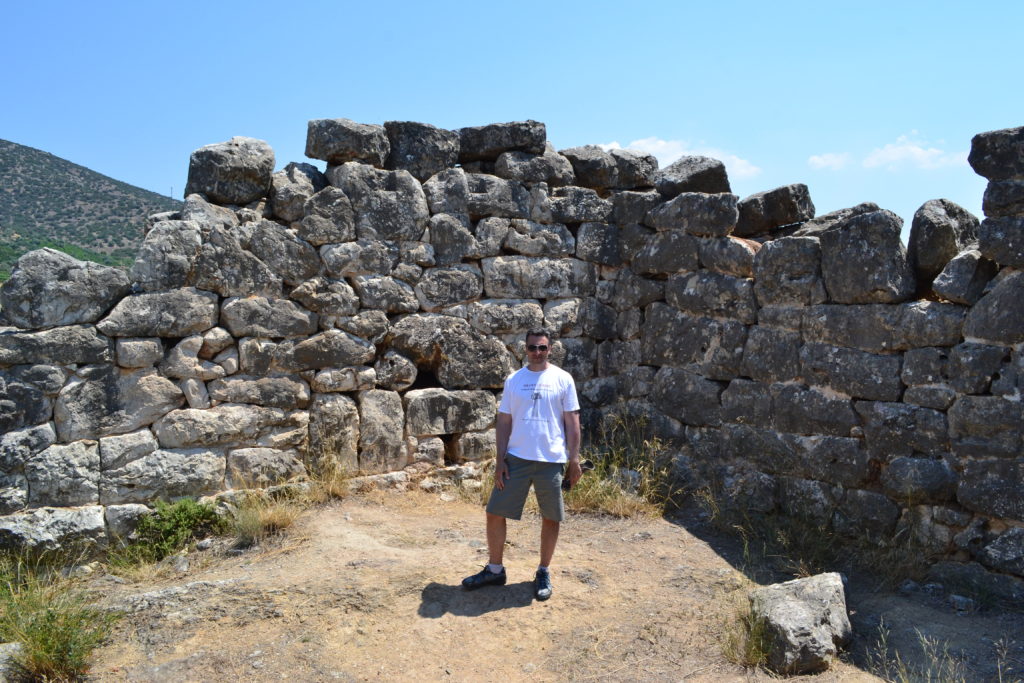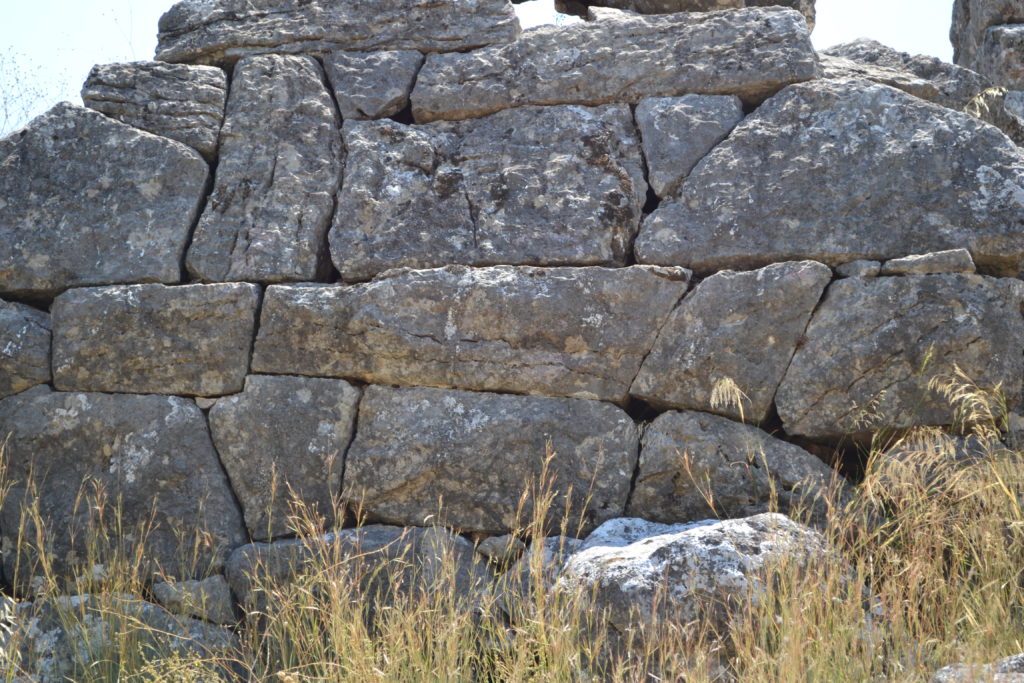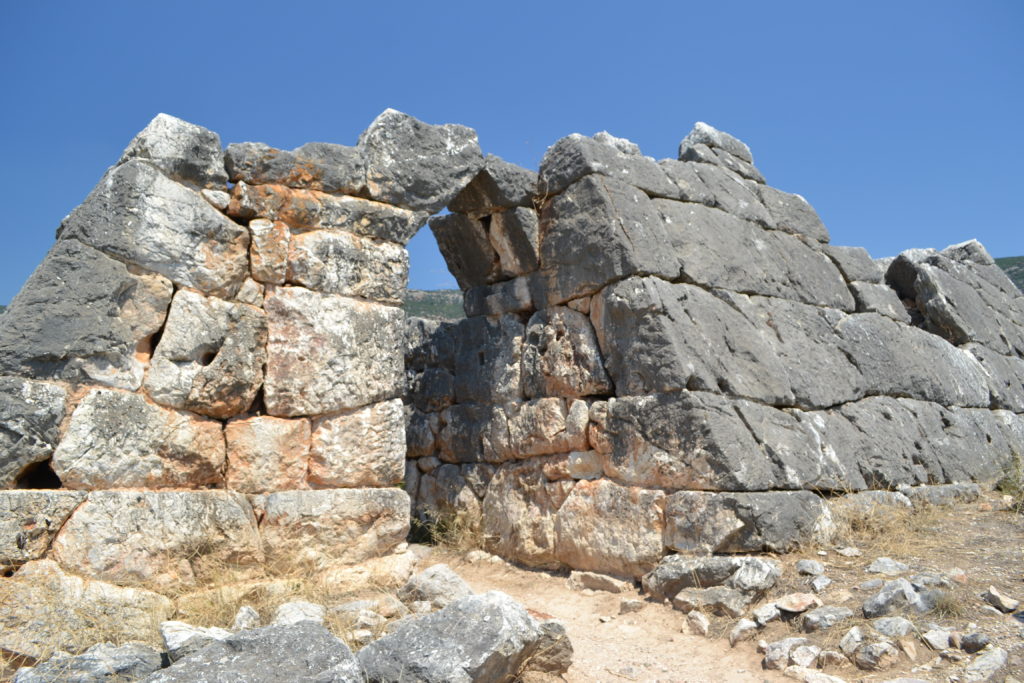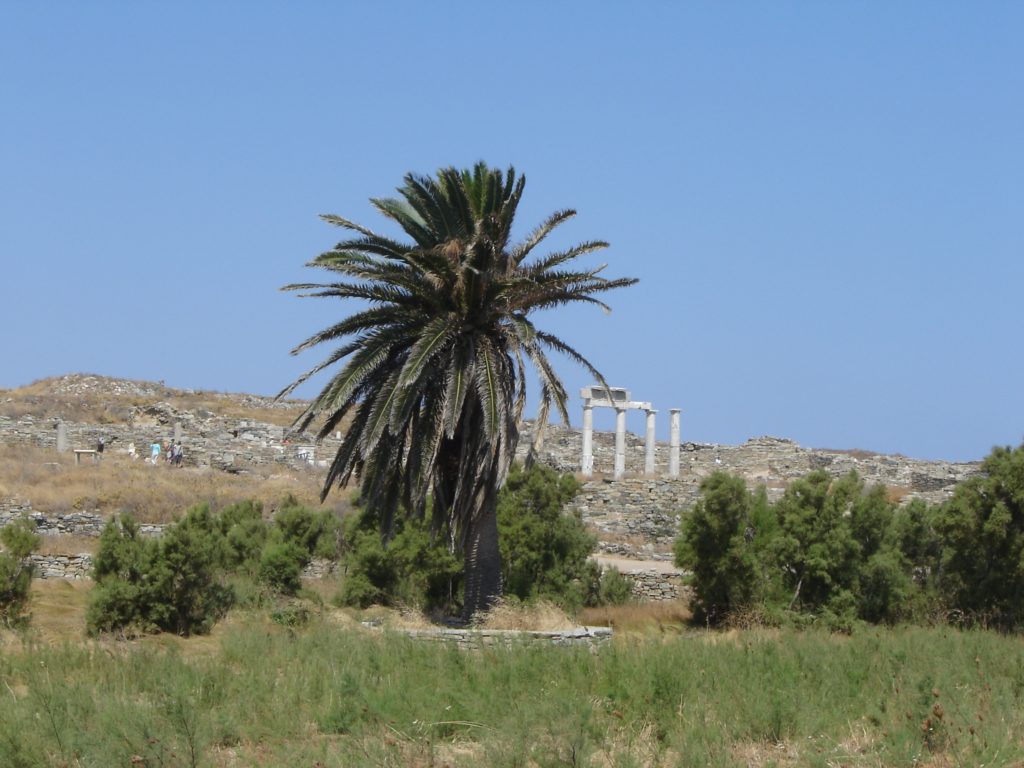archaeology
The World of Isle of the Blessed – Part I – The Dragon’s Domus
Salvete, readers and history-lovers!
Welcome to The World of Isle of the Blessed!
In this seven-part blog series, we’re going to be taking a look at the research that went into my latest historical fantasy release, Isle of the Blessed, Book IV in the #1 bestselling Eagles and Dragons series.
Over the next few weeks, I’ll take you on a journey through the world of early third-century Roman Britain in which we will look at the history, archaeology, and historical events that took place during this pivotal time in the Roman Empire in which the book is set.
In this first post, we’re taking a closer look at a site that is well-known to Arthurian enthusiasts: the hillfort of South Cadbury Castle.
At the very south ende of the chirche of South-Cadbyri standith Camallate, sumtyme a famose toun or castelle… The people can tell nothing ther but that they have hard say that Arture much resorted to Camallate. (John Leland, Royal Antiquary, 1532)
The hillfort of South Cadbury Castle in Somerset, England, is one of the major locations in Isle of the Blessed. However, most people are familiar with it as a site with strong Arthurian associations. As such, its importance and role is hotly debated.
Though Isle of the Blessed is not a story of King Arthur and the Knights of the Round Table, it is difficult not to speak of this important Iron Age site without discussing the Arthurian connection.
Was South Cadbury Castle the power centre of the historical Romano-British warlord, or dux bellorum, we know as ‘King Arthur’? Was this the actual site of what has come to be known in the popular imagination as ‘Camelot’?
I’ve always been a strong proponent of the theory that there was in fact, an historical ‘Arthur’ who formed the factual basis for all the legends we love and cherish. So, when I look at sites such as South Cadbury, I do so with that in mind. However, that doesn’t mean that I accept a site’s association with Arthur on faith alone.
I know this site pretty well – as I studied it and wrote about it as part of my Master’s dissertation entitled “Camelot: A look at the historical, archaeological, and toponymic evidence for King Arthur’s Capital”. As part of this, I looked at three of the main candidates for Camelot that had been put forward at the time – Wroxeter (Roman Viroconium), Roxburgh Castle (in the Scottish Borders), and South Cadbury. There is a copy of the dissertation hidden somewhere in the stacks at the St. Andrews University library in Scotland.
South Cadbury Castle is also where I cut my teeth as an archaeologist as part of the South Cadbury Environs Project team for a couple of seasons under the leadership of Richard Tabor. This was a wonderful experience that helped me to get up close and personal with the site I had studied for so long – I dug test pits, got into bigger trenches in which curious cows came to watch what I was doing, carried out geophysical surveys with a magnetometer, and found some curious objects such as a bronze dolphin that formed the handle of a Roman drinking cup.
Most of all, I was given the chance to spend more time on this amazing, and yes, magical, landscape.
And a couple years ago, when doing research for Isle of the Blessed, I returned to South Cadbury where I also filmed a mini-documentary on the site (coming out later this year!).
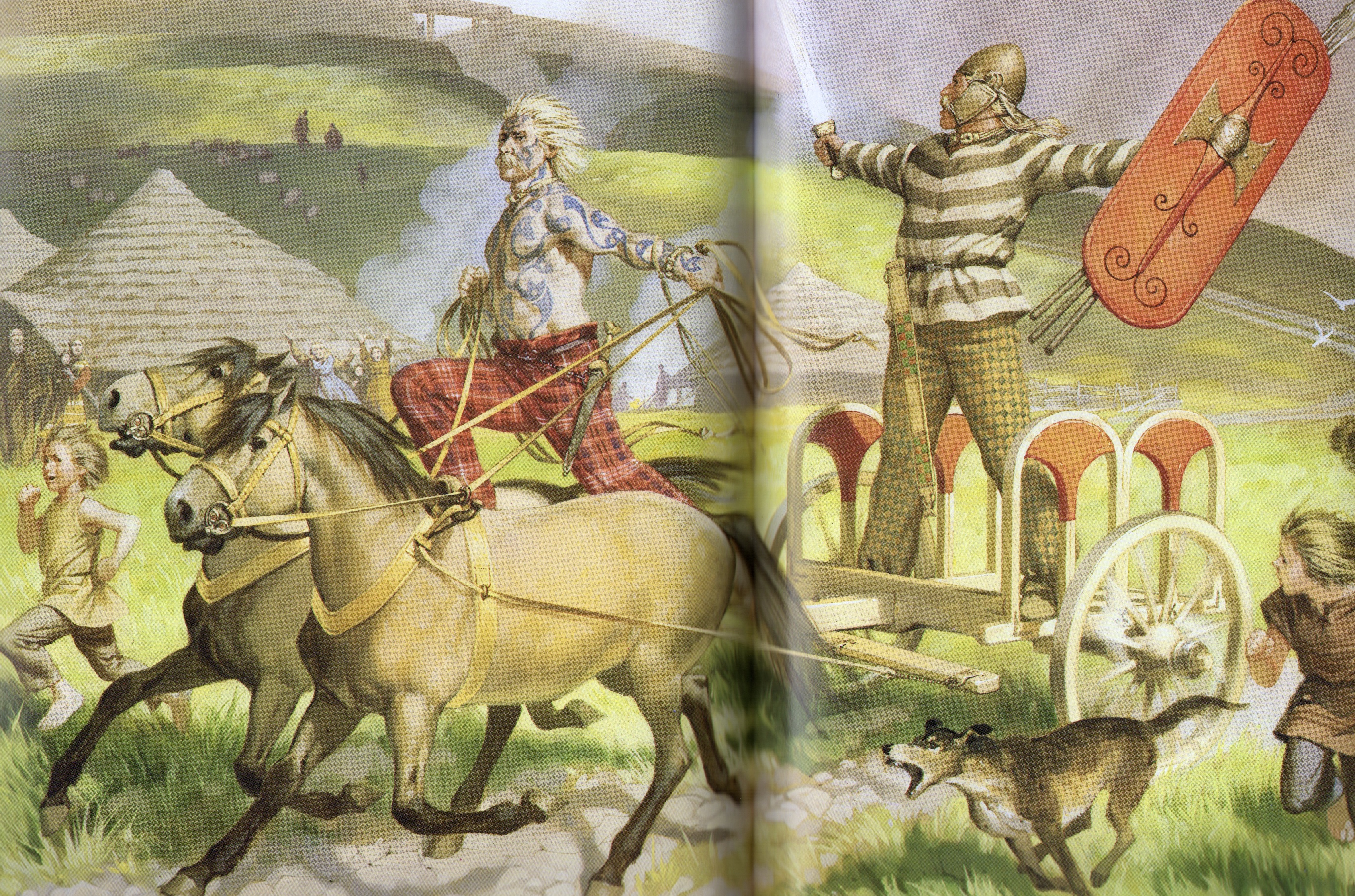
British Belgic Warriors of the Iron Age – Illustrated by Angus McBride (source – Rome’s Enemies 2 – Gallic and British Celts)
Before I give my thoughts on wandering the slopes of South Cadbury Castle, we should have a look at what it actually is.
South Cadbury Castle is not the late medieval castle with banners flying from tall towers that make up our usual image of Camelot. It is a 500 foot high Iron Age hillfort located in the pre-Roman era lands of the Durotriges. Occupation of the site began in the Neolithic period and it went through various stages of occupation from the 5th century B.C. onward.
By the time of the Roman invasion of Britain, it had four massive defensive ramparts with an inner area of about 18 acres. Access to the top was by two entrances, one to the north-east and the other, larger one, to the south-west. The Iron Age occupation of the site came to a violent end around A.D. 43 when Vespasian stormed the southern hillforts of Britannia.
The Romans made little use of the site, though there have been some theories that it was used as a Roman supply station. This theory is explored in Isle of the Blessed and the Eagles and Dragons series. In the 3rd and 4th centuries, there was renewed activity with visits being made to a Romano-Celtic temple that was built on the site.
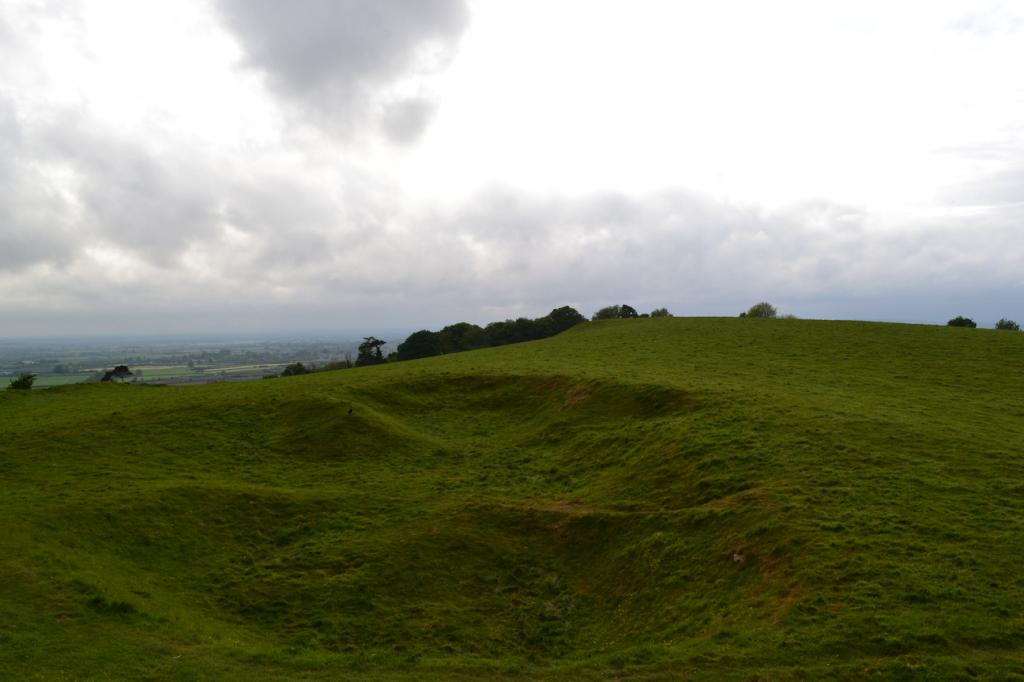
Location of the Romano-British temple in the south-east sector of the hillfort of South Cadbury Castle
During excavations, a bronze letter ‘A’ was found that some believe belonged to this temple, which was perhaps dedicated to Mars, or some other deity.
However, when it comes to South Cadbury Castle, the periods that have always drawn me to it are the 5th and 6th centuries A.D. This period of the site is known as the ‘Arthurian’ period, and it is at this time, after Rome’s legions had left the island, that the archaeology shows a massive refortification of the hillfort.
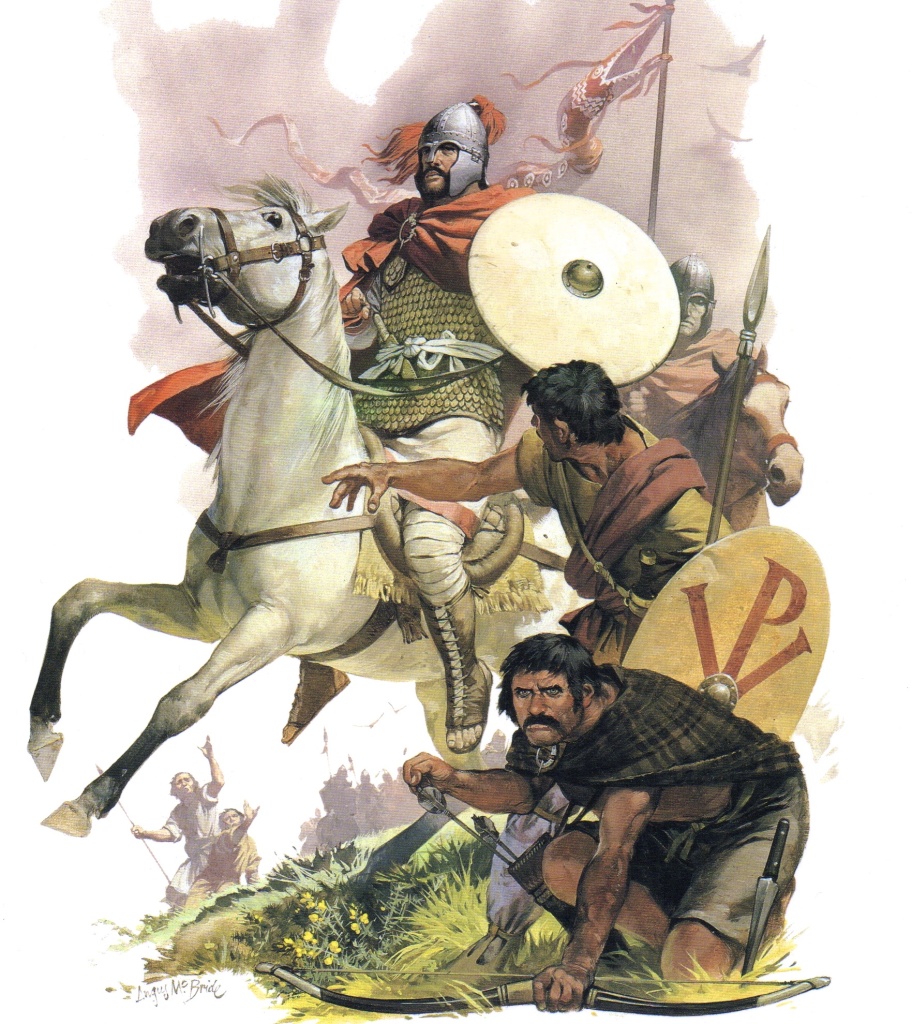
6th Century British Warriors – Illustrated by Agnus McBride (source – Arthur and the Anglo-Saxon Wars)
Though it is much debated, South Cadbury’s association with the Arthurian period stems not just from hearsay and folklore. It has the archaeological evidence to back it up.
There have been a few big excavations of the hillfort over the years, but the biggest of all took place in the late 1960s and was headed by Professor Leslie Alcock. Professor Alcock and his team discovered evidence for a large scale occupation and refortification of the hillfort, during the Arthurian period, which showed repaired defences, including a strong gatehouse at the south-west entrance, and most importantly, several buildings, including a kitchen and a large timber hall on the fort’s high plateau.
The discovery of post holes reveals a finely-built timber hall that was on a large scale, measuring about 63×34 feet. This hall would not have been the great castle hall of late medieval romance, but rather something like the timber drinking halls of the period, more like to the Golden Hall of Meduseld, the seat of King Theoden in Lord of the Rings.
Another very telling discovery at Cadbury Castle was the large quantity of Mediterranean pottery that dates to the Arthurian period of activity. This is the same pottery type that was discovered at Tintagel Castle in Cornwall, a site that also has strong Arthurian associations. One might think that shards of pottery from wine, olives and olive oil might be pretty mundane, but they anchor the sites strongly in the period, and also show that someone of importance was associated with the site. Not everyone could afford to import such things through trade.
The refortification of the hillfort during the Arthurian period was on a massive scale, and would have required many resources and men to hold it. South Cadbury castle was, in a way, on the front lines of the British struggle against the invading Saxons, and would have been well-placed to meet the Saxons as they advanced westward.
Based on the refortification, and evidence of the gatehouse that linked the ramparts running over the cobbled road at the south-west corner, this place was likely the base for an army that was large by the standards of the period. It may have been the site of the court of the dux bellorum, or the historical Arthur.

Artist Reconstruction of the South-west gate – Illustrated by Peter Dennis (Source – British Forts in the Age of Arthur)
I am only scratching the surface here, as far as the archaeological finds. For a more academic look at South Cadbury Castle, you will want to read the upcoming Historia series release Camelot: The Historical, Archaeological and Toponymic Considerations for South Cadbury Castle as King Arthur’s Capital. (Make sure you are signed-up to the mailing list be notified of that release)
South Cadbury Castle was finally abandoned in the early 11th century when it was being used as a royal mint during the reign of the Saxon king, Aethelred.
Today, South Cadbury Castle is a quiet hill in the midst of the Somerset countryside where it lies just south of the A303 motorway. The levels of its steep ring fortifications are now overgrown with trees and scrub, and cows roam the fields surrounding it.
When you visit, you pull your car into the small car park at the south end of the village of South Cadbury, just east of the hillfort. From the lane, you can’t really tell what you’re looking at. It seems like a steep, forested hill with a path leading up.
This path leads up to the north-east gate of the hillfort, and for me, it was always the gateway to another time, another realm.
It’s difficult to approach this site and reconcile the archaeologist/historian side of me with the romantic. Arthurian lore runs deep in my veins, and has had a hold on my psyche since I was very young. The first time I visited the site, I could almost hear the call of clear trumpets and the thumping of horses’ hooves upon the ground as knights returned home from their adventures, their horses brightly caparisoned, their armour shining brightly in the light of the Summer Country.
Of course, I know that is not how it was during the Arthurian period, but this is a place and story that fires the imagination. Cadbury Castle’s associations with Arthur include a hollow hill where he sleeps until he is needed again, the site of ‘Arthur’s Well’, a place on the slopes where his horse drank when he led the Wild Hunt, and of course the location of Camelot.
To me, however, the idea of South Cadbury as the main fortress of a Romano-British warlord leading a group of skilled cavalry in a last stand against the invading Saxons is no less romantic.
During my subsequent visits, I would ascend the dirt and rock path leading up to the northeast gate and pause with reverence for the history of the place. I would imagine looking ahead, up the slope to the central plateau of the hillfort to the great wooden hall where smoke from the hearth of Arthur’s hall wafted into the sky as he and his warriors discussed the fight for their lives and their Romano-British heritage.
The warriors that manned the ramparts of South Cadbury, who dined in the hall, and who rode out to meet the Saxons, have been wrapped in the fabric of myth, as much as the Isle of Avalon not ten miles distant, in Glastonbury. But they certainly left a mark on the place, on history and folklore.
As I walk the grass-covered ramparts of South Cadbury, watching the crows dive in the winds above the steep slopes, I can’t help but wonder if Arthur, Gawain, Bors, Tristan, Bedwyr, Cai and others walked that same path, a wary eye out for a sign of the enemy that would shatter the peace they had fought so hard for at the famed battle of Mons Badonicus.
Rarely have I felt so at peace and nostalgic as I have when walking around this hillfort. I can still smell the damp grass and feel the sun on my face. In my mind, I still watch the puffs of white cloud blowing over the Somerset landscape as I pause to gaze to the north-west and see Glastonbury Tor rising out of the earth.
In ages past, when the levels flooded, the distance between Cadbury Castle and Glastonbury might have been crossed by boat if you knew the way and which rivers to take. Indeed, one of the discoveries found around the hillfort was a boat.
South Cadbury Castle is, in some ways, closely tied to Avalon, and you can feel that as you look from the top of one to the other. This too is explored in Isle of the Blessed.
After making a round of the ramparts, and standing on the roadway of the south-west gate, I would always spend a good amount of time on the plateau, watching the sky and letting my imagination take hold.
The beauty of visiting a site, rather than looking at in a book or online, is that direct connection with the past, with the history of the place.
Yes, many of the stories we know and love about Arthur and the Knights of the Round Table are medieval fabrications. But I do believe that every legend has its base in fact, and so it’s a comfort to know that the layers of myth and legend are veined with elements of possible truth and history.
Many people will disagree, and that’s ok. When it comes to Arthur we will never reach a consensus.
However, considering the archaeological evidence at South Cadbury Castle, along with its location and the apparent activity during the Arthurian period, it seems quite possible that if there was an historical Arthur, he would undoubtedly have been familiar with this magnificent hillfort.
Was this just another strong point in the British defensive network? Or was it the Arthurian power centre that has come to be known as Camelot?
Whatever the answer is, it is surely fascinating, and perhaps unattainable. But then, that is what makes these historical mysteries so intriguing.
If you ever manage to roam the lands In Insula Avalonia, just be sure to make your way to South Cadbury Castle. Walk up the steep slopes, and through the gate, and know that you may just be walking in the footsteps of Arthur.
I hope you’ve enjoyed this first part of The World of Isle of the Blessed.
Be sure to tune in for Part II in which we will look the history of another setting in Isle of the Blessed: the village of Ilchester, Roman Lindinis.
Thank you for reading.
Isle of the Blessed is now available in e-book and paperback from all major on-line retailers. If you haven’t read any books in the Eagles and Dragons series yet, you can start with the #1 bestselling A Dragon among the Eagles for just 0.99! Or get the first prequel novel, The Dragon: Genesis, for free by signing-up for the newsletter HERE.
The Pylos Combat Agate and the Griffin Warrior Tomb
They came to Pylos, Neleus’ strong-founded citadel, where the people on the shore of the sea were making sacrifice of bulls who were all black to the dark-haired Earthshaker. There were nine settlements of them, and in each five hundred holdings, and from each of these nine bulls were provided.(The Odyssey)
Pylos is a name out of time and legend, immortalized by Homer in the Iliad and the Odyssey, as was the name of Nestor, the son of Neleus and Agamemnon’s right-hand man and aged advisor during the war with Troy.
When you look at the archaeology of the Mycenaean Bronze Age in Greece, one inevitably thinks of places such as Mycenae, Tyrins, and yes, Pylos. These sites are well known.
There is, however, a misconception outside of the world of archaeology that everything has already been found.
This is far from the truth. Archaeologists are excavating new finds all the time, sometimes aided by drought and fire, other times by desperately-needed funding to back strong theories or even hunches about locations.
Pylos is no exception.
In the world of ancient Greece, one of the most exciting finds in the last few years is that of the Pylos Combat Agate and the discovery of the Griffin Warrior Tomb.
In today’s post, we’re going to take a look at the tomb and the array of magnificent finds that are challenging previous notions of the evolution of ancient Greek art.
First off, what exactly is at the site of Pylos?

View of the megaron in the Palace of Nestor at Pylos, published by Carl Blegen in the AJA in 1956 before the first roof over the palace was built (image copyright held by the Department of Classics at the University of Cincinnati)
Pylos is located in the southwest of the Peloponnesian mainland of Greece. The palace there is the best-preserved Mycenaean palace yet discovered, said to be the power centre of King Nestor, whose ships joined the Greek army sailing for doomed Troy.
The palace of Pylos was located on a hill within the larger settlement that was, it is supposed, surrounded by an outer wall. It was made up of two storeys with various rooms, workshops, baths, reception rooms, and even a sewage system.
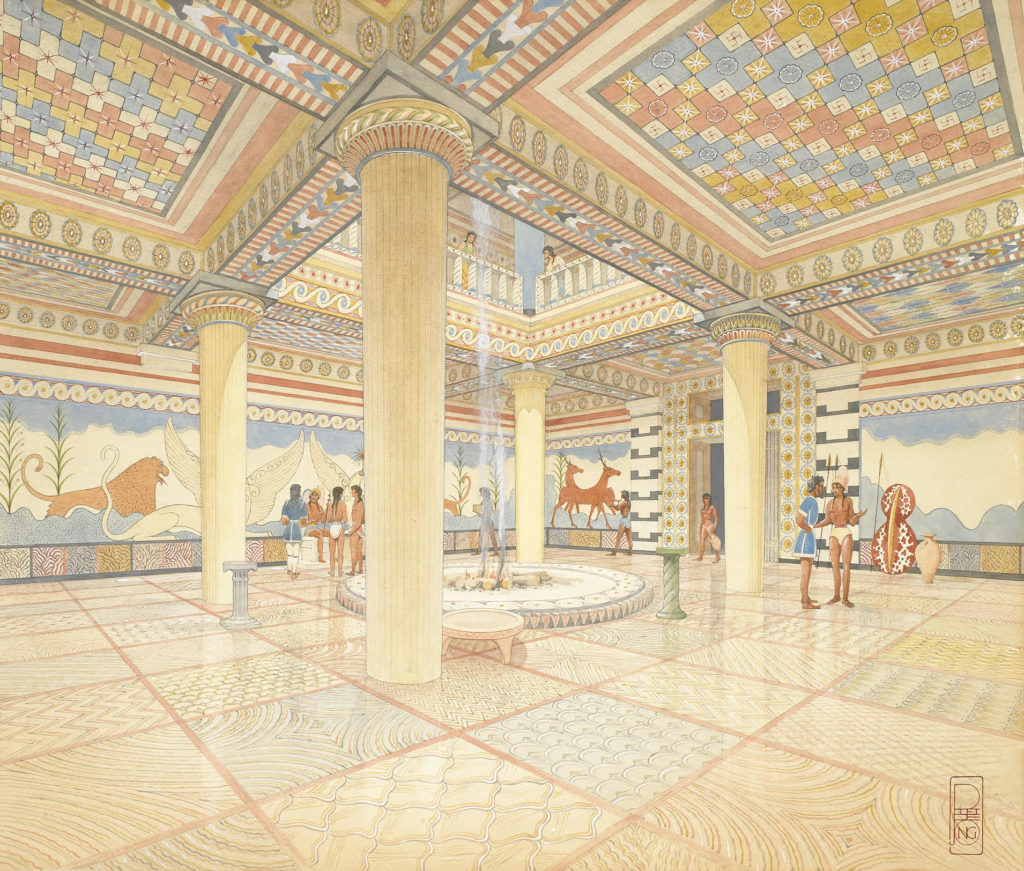
Watercolor reconstruction of the Throne room of Nestor’s Palace by artist, Piet de Jong (Image copyright by the Department of Classics at the University of Cincinnati)
Excavations at Pylos occurred in 1912 and 1926 when two tholos tombs were discovered in the area, but it was in 1939 that a proper, joint Greek-American excavation got underway. This was led by famed archaeologist Carl Blegen, from the University of Cincinnati. Blegen’s initial excavations of Pylos revealed walls, frescoes, Mycenaean pottery, and a royal archive of one thousand tablets.
World War II put the dig on hold for a while, but you can’t keep determined archaeologists down! In 1952, the palace was finally uncovered.
I’ve not been to this site personally yet, but it is definitely on my ‘to visit’ list! Here is a virtual tour of the palace at Pylos:
The University of Cincinnati has continued to excavate at Pylos since Blegen first became involved, more recently under the leadership of the archaeological husband-and-wife team of Jack L. Davis and Sharon Stocker who are responsible for the recent and fascinating discovery of what has become known as the ‘Griffin Warrior Tomb’.
What is the Griffin Warrior Tomb?
It is an undisturbed (and un-looted!) shaft tomb dating to about 1450 B.C. (before the Trojan War). It contained the intact remains of a long-haired adult male of thirty-something, of about 5 ½ feet tall, whose wooden coffin was located in the tomb along with over 3500 grave goods.
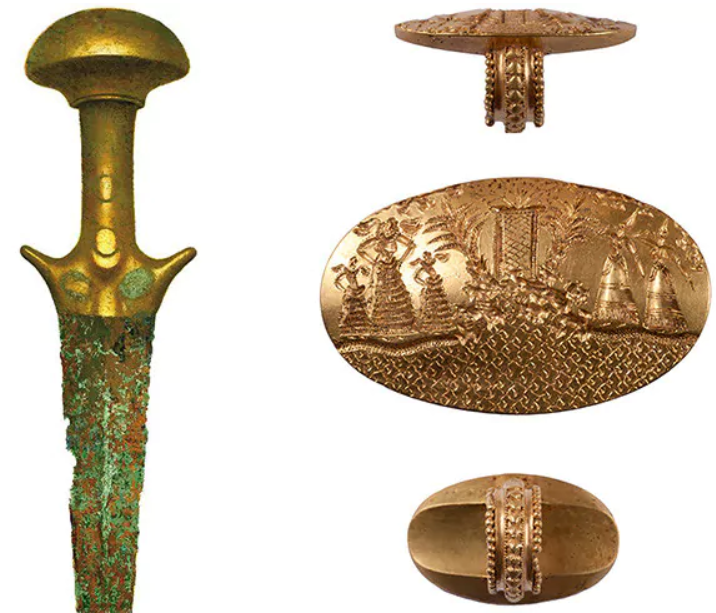
Sword and Ring from the Tomb (image copyright by the Department of Classics of the University of Cincinnati)
The grave finds included bronze weapons, armour, jewels and jewellery, mirrors, many items of silver and gold, signet rings, ivory combs, boar tusks (perhaps from a helmet), and more. It is interesting and important to note here that some of the goods are decorated with uniquely Minoan motifs.
There was also an ivory plaque between the warrior’s legs with a carved relief of a griffin. Presumably, this is where they came up with the name of this tomb.

Artist recreation of the Griffin Warrior Tomb as excavated (image copyright by the Department of Classics of the University of Cincinnati)
The tomb was located in an olive grove near the palace of Nestor, but within the Bronze Age city of Pylos.
We have no idea who this man was, but it seems likely that he was a warrior who was both rich and important. It is telling that he was buried not with many ceramic goods, which is common for warrior graves from the age, but rather with much gold and silver and finely wrought weapons. It is also thought that he could have been a priest of sorts due to the fact that many of the grave goods are ritual objects.
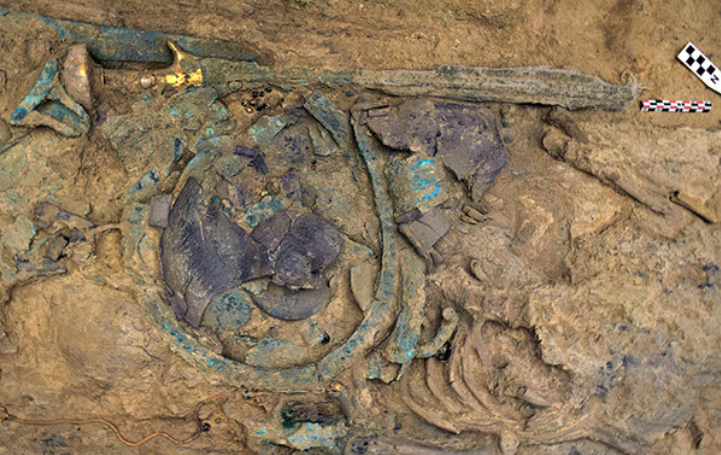
Grave finds of Griffin Warrior Tomb (image copyright by the Department of Classics of the University of Cincinnati)
Project co-directors Sharon R. Stocker and Jack L. Davis of the University of Cincinnati note: “The team did not discover the grave of the legendary King Nestor, who headed a contingent in the Greek forces at Troy. Nor did it find the grave of his father, Neleus. They found something perhaps of even greater importance: the tomb of one of the powerful men who laid foundations for the Mycenaean civilization, the earliest in Europe.”
This is pretty exciting!
More research and analysis of the finds is, of course, already underway. The exciting thing is that it is thought that more will be discovered about the relationship between the Mycenaean mainland and Minoan Crete.
I’m only summarizing things here. There is a lot more to read about this excavation and the finds and I’ll provide some links at the end of the blog.
Before I do, however, I wanted to touch on the one find that has truly captured the imagination of many around the world, especially my own…
The Pylos Combat Agate.
Here it is:
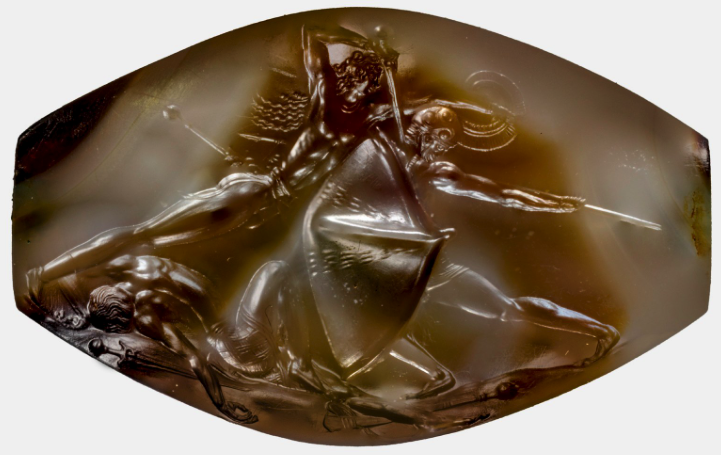
Image of the Pylos Combat Agate (image copyright by the Department of Classics of the University of Cincinnati)
Isn’t it stunning? Of all the wonderful finds in the Griffin Warrior Tomb, this is the one that pulls me in.
What is it?
At this point, it’s thought to be a Minoan seal that was created around c. 1450 B.C.
It’s named for the fierce combat that it portrays, and is now considered the best work of glyptic art (a symbolic figure carved or incised in relief) ever from the Aegean Bronze Age. In fact, such quality, skilled work in this style was not seen until the Classical Age about a thousand years later!
Who made this gem, and what is the scene being portrayed? Now that’s story to consider!
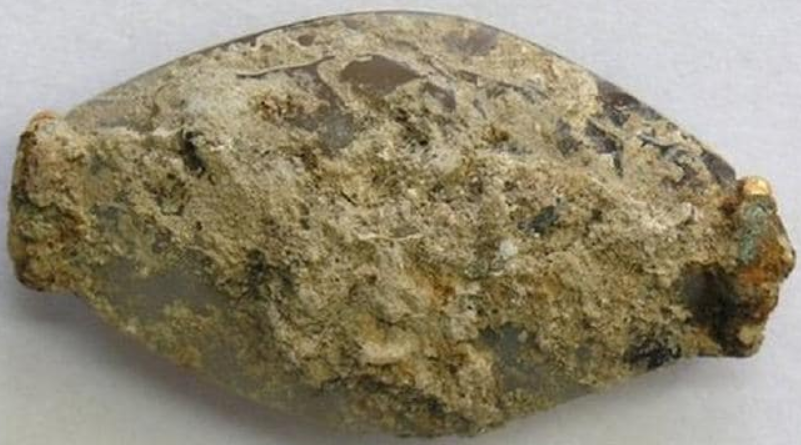
Pylos Combat Agate before restoration (image copyright by the Department of Classics of the University of Cincinnati)
This magnificent artifact is made of agate and is about 3.4 centimeters (1.3 inches) wide. In the Griffin Warrior Tomb, it was found along with four other signet rings with other engravings such as Minoan bulls.
It is believed that this was obtained from Minoan Crete by Mycenaeans, either by import or theft.
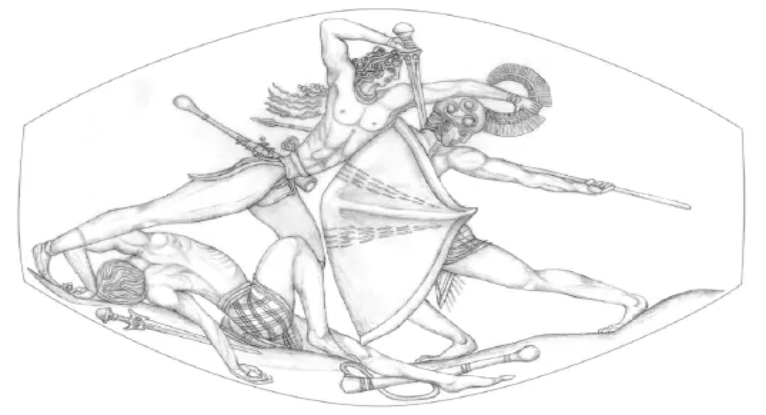
Artist Sketch of the Pylos Combat Agate Scene (image copyright by the Department of Classics of the University of Cincinnati)
Science, archaeology, and history aside…how does this scene make you feel?
The scene depicted is of a vicious battle with an unarmoured, long-haired warrior engaged in a brutal combat with a heavily armoured warrior. The former stands upon the body of a man he has already slain.
We don’t know anything else about this artifact, and we probably never will. But the possibilities are thrilling, aren’t they?
That’s one thing I love about archaeology – the potential for stories.
Every one of the artifacts found in the Griffin Warrior Tomb has a story behind it – how it was made and why, by whom? How did the artifacts come to be in the possession of this wealthy warrior and what meaning did they hold for him?
You can go on and on. Truly, there’s an entire book series to be written about this one man!
I was so inspired last year by the discovery of this artifact that I wrote an ‘Inspired by the Past’ short story about it which is available to all Centurion-level supporters on the Eagles and Dragons Publishing Patreon page.
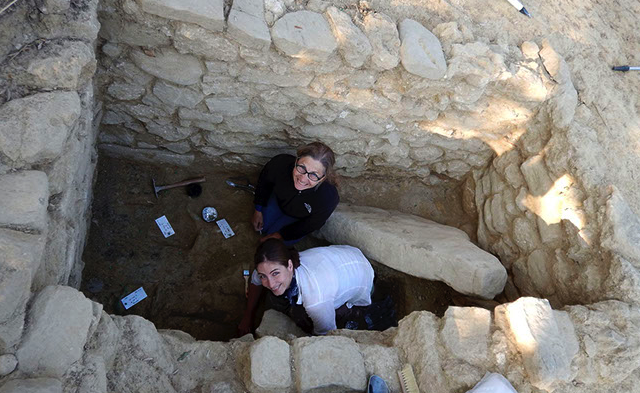
Jonida Martini and Sharon Stocker excavating the upper layer of artifacts immediately after bronze was discovered. (image copyright by the Department of Classics of the University of Cincinnati)
I’ve only scratched the surface of the history and finds related to the Griffin Warrior Tomb at Pylos, but I hope you’ve found it interesting and that it has inspired you to discover more.
To find out more about the archaeological team, the project and finds, I highly recommend visiting the website set up for the project at: http://www.griffinwarrior.org/griffinwarrior-burial.html
You can also watch the interviews on Greek media with the lead archaeologists on the project, Jack L. Davis and Sharon Stocker. Their excitement and enthusiasm for the finds is contagious and inspiring! Check out the video below (and cue the dramatic Greek news show music!)
Thank you for reading!
Roman Ghosts – Sentries of the Saxon Shore
Salvete, Readers!
Today we have our second post in the Roman Ghosts series, and this one is guaranteed to give you shivers.
If you missed the first post about Shades in Eburacum, you can check it out by CLICKING HERE.
Many of you have written to us about Roman ghost sightings in the UK, and we are keen to research them and share with everyone. Rest assured, they’re all on the list! Today’s post comes by way of a tip from Eagles and Dragons reader, Michael Dennis.
This particular look at Roman ghosts takes us to Reculver on the Kentish coast in England, in particular a site on the promontory at the mouth of the Watsum Channel, facing the Isle of Thanet.
Before we get into the spectral sightings associated with this remote location, we should, of course, look briefly at the history of the place.
Reculver was the site of Roman Regulbium which comes from the Celtic name meaning ‘at the promontory’.
It was on this site during the Claudian invasion of Britain in A.D. 43 that a Roman fortlet was first built. Tense times in the land, of course. Eventually, the fort was connected by road to the settlement of Durovernum, modern Canterbury.
Eventually, in the late second century, a larger Roman castrum was built on the site, and this included a basilica as part of the principia (headquarters building), barracks, a bathhouse, and even a nearby oven which was located outside the walls. The walls themselves were almost fifteen feet high and ten feet thick. Sadly, much of the fort has been lost to the sea and erosion.
What does remain are two of the Roman towers which were incorporated into the early medieval Saxon church of St. Mary’s. More on these towers later…
The Notitia Dignitatum, the great Roman administrative document of the early fifth century, indicates that the Cohors I Baetasiorum was stationed at Regulbium. These troops of the Baetasii tribe inhabiting the lands between the Rhine and the Meuse, in Germania Inferior, were a good distance from their homes.
Regulbium was apparently abandoned after A.D. 360, but from what we have been reading, it may well be that some of the troops never went home.
Try and imagine a soldier, or a cohort of soldiers, based in a specific location for an extended period of time. Routine and disciplina, as the Romans called it, were central to a soldier’s life. Sometimes they lived and died in a specific place, had families, lost loved ones, took life and shed blood.
Well, in Regulbium to this day, it seems that some of the Roman soldiers are determined to keep to their schedules and their posts.
There have been many reports of Roman soldiers seen on patrol at Reculver fort (Regulbium) or keeping ghostly sentry duty there, so much so that visitors, even in summer, claim that there is something very ‘wrong’ about the place.
Apparently, the site of the Roman fort is so haunted that it has become a destination for amateur ghost hunters!
But it isn’t just the ghosts of groups of Roman soldiers on patrol that people have reported seeing. There have also been chilling reports of a lone Roman soldier standing stolidly at his sentry post somewhere between the two remaining towers that stand there to this day.
What might the shade of that Roman be looking out for? A returning patrol? Raiding Saxon ships coming into the isle between the fort and Thanet?
Who knows? One thing is for sure, there are more than just the shades of Roman soldiers lurking around the fort.
There have also been numerous reports of phantom babies crying on the wind when people have visited the fort!
One might think that this is just the gusting wind playing tricks on visitors to the fort. Then again, perhaps not.
When excavations were carried out at the fort, the burials of ten infants were found within the fort itself, and six of these were associated with specifically Roman buildings.
There are some theories that the infants were part of a ritual sacrifice there, but it is not known if they were dead already (stillborn), or if they were killed as part of the ritual.
Seeing as Romans more or less frowned on human sacrifice (apart from in the arena), the slaying of babies does seem to be a bit of a stretch, but one never knows. Perhaps the Baetasii tribe from the Rhine region did that sort of thing, perhaps not.
Either way, the remains of infants have been found, and whatever the circumstances of their deaths, it seems likely that the wailing of their little shades at the fort would be enough to turn the legs of the toughest legionary to mush.
Have you been to the ruins of Regulbium? Would you go after reading this?
I’m not sure I would.
We hope you’ve enjoyed this second post in the Roman Ghosts series. For more information on the haunted site you can check out the book Haunted Kent, by Janet Cameron.
For information about the archaeology and ruins of Roman Regulbium, you can check out the Historic England page by CLICKING HERE.
Remember, if you know of any Roman ghost stories in any part of the former Roman Empire that you would like to share, just send us an email through the Contact Uspage of the website and we’ll look into it.
Thank you for reading!
Pompeii – A Brief Introduction with Archaeologist, Raven Todd DaSilva
Hello again, ancient history-lovers!
Way back in the dark days of February, archaeologist Raven Todd DaSilva came to speak to us about gladiators and the famous thumbs-up gesture that we associate with that ancient blood sport. If you missed that, you can check it out HERE.
I’m thrilled to say that Raven is back on the blog with us this week for a brief introduction to one of the great disasters of the Roman world: the destruction of Pompeii.
Raven visited the archaeological site of Pompeii recently and is here to share a bit of the history with us, as well as some new theories around dating, as well as one of her brilliant videos!
So, ready as ever to get digging and get dirty, here’s Raven Todd DaSilva…
Pompeii, a Brief Introduction
By: Raven Todd DaSilva
On an unassuming day in 79 CE, the long-dormant Mount Vesuvius erupted. For three days, volcanic ash and rock rained down on the surrounding area, completely devastating the settlements around it. Most famously- the city of Pompeii.
Founded in the 6th century BCE along the Sarno river, Pompeii originated as a local settlement in Campania. The rich volcanic soil made it favourable for agricultural activity. In the 5th century BCE, the Samnites entered the area, while the 4th century BCE saw the beginning of Roman influence on the region. Pompeii began to flourish under this regime with massive building projects. It became a major port on the Bay of Naples, leading to its “golden age” in the 2nd century BCE. Pompeii was later turned into a seaside resort in 81 BCE. An earthquake damaged many of the buildings in 62 CE, which led to significant economic decline. By the time of the eruption, many of the grand villas built in the 2nd century BCE were converted for public use, leaving the city frozen in time during a period when its glory days were behind it.
Of course, Pompeii gets its fame from the devastating catastrophe because of the rare view it gives us regarding daily life at that time. As the eruption took the city’s inhabitants by surprise, they were not able to properly pack up and evacuate the area, leaving archaeologists with invaluable evidence as to how people really lived in the first century CE.
Not only are we fortunate enough to have the physical site of Pompeii, we also have a primary document describing the eruption of Vesuvius and the immediate aftermath. Pliny the Younger described the events that happened to his uncle, Pliny the Elder, who died assisting refugees onto the warships he was overseeing. This account is also where the infamous quote “Fortune favours the brave” originated. We also have Pliny’s own personal account from Misenum (about 30km away).
The eruption has been described by Pliny the Younger as:
…a pine tree, for it shot up to a great height in the form of a very tall trunk, which spread itself out at the top into a sort of branches; occasioned, I imagine, either by a sudden gust of air that impelled it, the force of which decreased as it advanced upwards, or the cloud itself being pressed back again by its own weight, expanded in the manner I have mentioned; it appeared sometimes bright and sometimes dark and spotted, according as it was either more or less impregnated with earth and cinders.(Letter LXV – To Cornelius Tacitus)
Once the danger of this eruption was realised, people began to evacuate hurriedly, with many people successfully fleeing. Pliny described those escaping as having “pillows tied upon their heads with napkins; and this was their whole defence against the storm of stones that fell around them” (Letter LXV). The stones thrust from the volcano were deadly, crashing through roofs, collapsing buildings and crushing those trying to take refuge under stairs and in cellars. Others, like Pliny the Elder, choked to death on the air as it filled with ash and noxious sulfurous gas. It is believed that 30,000 people died from the eruption.
The traditional date of the eruption is August 24th, as reported by Pliny the Younger, but it has come under scrutiny as further scientific evidence has come to light. Even as early as 1797, the archaeologist Carlo Maria Rosini questioned the date. Rosini reasoned that, as fruits found preserved at the site, such as chestnuts, pomegranates, figs, raisins and pinecones, become ripe in the fall months, they would not have been ripe so early in August. Another study of the distribution of the wind-blown ash at Pompeii supports this theory further. Probably one of the most telling artefacts is a silver coin found that was struck after September 8th, AD 79. As we don’t have an original copy of Pliny’s manuscript, we can assume a typo had been made along the way.
After compiling all this new data, a new eruption date of October 24th, 79 AD has been suggested.
After the eruption, the city remained largely undisturbed until 1738 when Charles of Bourbon, the King of Naples dispatched a team of labourers to hunt for treasures to give to his queen, Maria Amalia Christine, who was enamoured by previously excavated Roman sculptures in the area of Mount Vesuvius. The city of Herculaneum was found first, with Pompeii excavations following it about ten years later.
Today, Pompeii is one of the most popular and well-known archaeological sites, with the longest continual excavation period in the world. With respect to the study of daily life of Rome, it is undeniably important due to the sheer amount of data available. Each year, thousands of visitors flock to Pompeii to walk along the large stone slabs of its roads, visit its iconic brothels, and marvel at the mosaics, wall paintings and body casts preserved by the volcanic ash.
Raven Todd DaSilva is working on her Master’s in art conservation at the University of Amsterdam. Having studied archaeology and ancient history, she started Dig It With Raven to make archaeology, history and conservation exciting and freely accessible to everyone. You can follow all her adventures on Facebook and Instagram @digitwithraven
Resources
Online Articles:
Kris Hirst, What 250 Years of Excavation Have Taught Us About Pompeii https://www.thoughtco.com/pompeii-archaeology-famous-roman-tragedy-167411
Mark Cartwright, Pompeii https://www.ancient.eu/pompeii/
Joshua Hammer, The Fall and Rise and Fall of Pompeii https://www.smithsonianmag.com/history/fall-rise-fall-pompeii-180955732/
Andrew Wallace-Hadrill, Pompeii: Portents of Disaster http://www.bbc.co.uk/history/ancient/romans/pompeii_portents_01.shtml
James Owens, Pompeii https://www.nationalgeographic.com/archaeology-and-history/archaeology/pompeii/
Wilhelmina Feemster Jashemski, Pompeii https://www.britannica.com/place/Pompeii
The Two Letters Written by Pliny the Younger about the Eruption of Vesuvius in 70 A.D. – http://www.pompeii.org.uk/s.php/tour-the-two-letters-written-by-pliny-the-elder-about-the-eruption-of-vesuvius-in-79-a-d-history-of-pompeii-en-238-s.htm
Books:
Beard, Mary (2008). Pompeii: The Life of a Roman Town. Profile Books. ISBN 978-1-86197-596-6
Butterworth, Alex; Laurence, Ray (2005). Pompeii: The Living City. St. Martin’s Press. ISBN 978-0-312-35585-2
Kraus, Theodor (1975). Pompeii and Herculaneum: The Living Cities of the Dead. H. N. Abrams. ISBN 9780810904187
As ever, I’d like to thank Raven for another fascinating post and video.
Pompeii is one of those topics that I never tire of, and the exciting thing is that more is being revealed all the time. It’s also one site that I have not yet had the chance to visit, so I really enjoyed learning a bit more.
And I’m definitely looking forward to that next collaboration and video, Raven!
If you haven’t already done so, be sure to check the Dig It with Raven website and subscribe to Raven’s YouTube channel so you can stay up-to-date on all the latest videos about archaeology, history and art conservation.
Cheers, and before you leave, here’s a fantastic time lapse video of Raven’s visit to Pompeii!
A Turn of the Thumb: Gladiators and the Thumbs Up
Greetings ancient history fans! We hope you enjoyed last week’s blog post on the origins of gladiatorial combat and the different types of gladiators. If you didn’t read it, you can check it out by CLICKING HERE.
This week we’re venturing farther into the world of gladiators with a special guest post by archaeologist Raven Todd Da Silva.
Everyone who is familiar with popular representations of gladiators and gladiatorial combat will be familiar with the ‘turn of the thumb’ gesture, but do you know how that expression came about? Is it historically correct? Why was the thumb so important to Romans?
Well, Raven is going to demystify that for us. Take it away, Raven!
A Turn of the Thumb: Gladiators and the Thumbs Up
By: Raven Todd Da Silva
The notion of signaling life or death for a defeated gladiator by a thumbs up or thumbs down has been made popular by famous pieces of artwork and the 2000 film Gladiator.
But what is the real importance of our thumbs (digitus pollex), and how did it really function in the gladiatorial games of Ancient Rome?
The Romans were unique in comparison to other civilizations in referring to the thumb as its own digit on the hand, and it’s suggested that they believed it to have power or hold sway (polleat) over the rest of the fingers. The Latin word for thumb, pollex, is also said to have derived from the word for power, pollet. So we can see here just how much influence a gesture with the thumb had.
In the days of the gladiatorial games, the audience could have their say in deciding the fate of the fallen combatants with a hand gesture – what we think of as thumbs up or thumbs down in today’s misconstrued pop culture-reliant society. The decision to kill the fallen gladiator was decided with what is know as the pollice verso – which translates only as “turned thumb”. If we look at Juvenal, he says:
to-day they hold shows of their own, and win applause by slaying whomsoever the mob with a turn of the thumb bids them slay. (Juvenal; Satire III 36)
The Christian poet Prudentius also backs this up when talking about a Vestal Virgin watching the games:
The modest virgin with a turn of her thumb bids him pierce the breast of his fallen foe (Prudentius; Against Symmachus II)
We aren’t sure what this exactly means though, and there are no other proper surviving texts to give us specific insight. Contrary to popular belief, the “thumbs up” we all know today as a sign of a good job or to show that everything is A-OK did not always have this meaning. A study by Desmod Morris shows that Italians did not consider this action as a positive one until American pilots, who used it to signal to the grounds crew that they were ready to take off, imported it in WWII.
So we don’t really know which way the audience’s thumbs were pointing to indicate if they wanted the gladiator to die.
But if an extended, turned thumb indicated the kill, what did the audience do if they wanted to spare the gladiator’s life? Martial stated that the crowd appealed for mercy by waving their handkerchiefs (XII) or by shouting (Spectacles, X).
It seems the gesture was possibly to hide your thumb inside of your fist known as the pollice compresso or “compressed thumb”. Anthony Corbeill, the leading expert on ancient Roman gestures has translated Pliny’s pollices premere to mean that a thumb pressed down on the index finger of a closed fist signified mercy.
There’s some speculation with the reasoning behind these two gestures. Firstly, it’s a lot easier to tell the difference from the crowd. Second, it could indicate the state of the gladiator’s sword. Extended thumb indicating that the audience wanted the gladiator to give the conquered one final stab or blow, and the compressed thumb telling the victor to sheath his weapon and grant mercy on the defeated.
Archaeologically speaking, the The Médaillon de Cavillargues, located in the Nîmes Musée Archéologique supports Corbeill’s conclusions. Also interesting to note, the gladiator may have had to wait for a judgment call from the producer of the games to know the true outcome from the audience vote – waiting for an audible cue in the form of a horn or some music, which is suggested in the Zliten mosaic.
One of the most famous paintings depicting gladiatorial combat is called the Pollice Verso, painted in 1872 by famous historical painter Jean-Léon Jérôme. It displays a victorious gladiator standing over his vanquished opponent, showing off to a crowd enthusiastically thrusting their thumbs down. Jérôme was a highly respected historical painter, known for his extensive research and accuracy, which is why this misrepresentation lead to so many misunderstandings from the general public and fellow academics.
Raven Todd DaSilva is working on her Master’s in art conservation at the University of Amsterdam. Having studied archaeology and ancient history, she started Dig it With Raven to make archaeology, history and conservation exciting and freely accessible to everyone. You can follow all her adventures on Facebook and Instagram @digitwithraven
Resources
The Gladiator and the Thumb
“Thumbs in Ancient Rome: pollex as Index.” Memoirs of the American Academy in Rome 42 (1997) 61-81 Anthony Corbeill
Juvenal Satire Book 3
Nature Embodied: Gesture in Ancient Rome (2004) by Anthony Corbeill
Zliten Mosaic
Pollice Verso
I’d like to thank Raven for taking the time to share this fascinating research with us. To be honest, I had no idea the Romans thought of the thumb as a digit that held sway over the other fingers!
You can read more by checking out the list of resources above.
If you have any questions for Raven about the ‘turn of the thumb’, you can ask them in the comments below.
Also, be sure to check out her website Dig It With Raven where she has a wealth of information on archaeology, history and art restoration.
Raven also posts regular VLOGS about archaeology and art restoration that are fascinating and highly informative. She’s also really funny! For anyone wanting to get their feet wet in these subject areas, I can’t recommend the videos enough. Make sure you subscribe to her YouTube channel so you don’t miss any of her awesome and educational videos.
We’ll definitely have Raven back on the blog!
Thanks for stopping by, and thank you for reading!
The Legend of Homer – A special guest post by author Luciana Cavallaro
Hi everyone,
Today I’d like to welcome back a special guest and fellow historical fantasy author, Luciana Cavallaro.
Luciana is something of an expert on Homer and the Trojan War, and she always has some fascinating thoughts on the subject.
So, sit back, relax, and let yourself be transported back to the age of heroes…
I’d like to thank, Adam, for inviting me to be on his blog and to talk about my favourite topic, ancient history. I am very grateful to Adam as well, as this is the second time I’ve been invited to write a guest post for his amazing and informative blog.
With the constant turmoil in the world, whether it’s acts of terrorism, North Korea’s Kim Jong-un’s threats of war, and the barbarous nature of inhumanity, it goes to show how history repeats itself. This blog post isn’t a “doom and gloom” article, but more of a commentary on the early recorded history of war that birthed western literature.
Wouldn’t it be great if one could meet and interview their literary heroes, to learn what drove their passion and pursuit for telling stories? I often wonder what it would be like to sit down and have a chat with Homer, the bard responsible for western literature and legendary tales. I’d like to think our conversation would be an intellectual discourse, but truth told, I’d be blubbering idiot. The brain would freeze and I’d be tongue-tied, and starry-eyed!
There’s not a lot of information about Homer, though speculation suggests he was born around the 8th Century BCE. As to where, no one is sure, except it was a Greek city in western Turkey. There was one element that most historians agree on was that he was blind, and that he was injured in a war he had fought in. This lends credence to the graphic and accurate descriptions he gave in the fight scenes in the Iliad. From the various sources I’ve read, each have commented he must have experienced war to able to describe the layout of camps, strategies in fighting, and the terrible injuries inflicted.
However, historians questioned as to whether he was the “author” of The Iliad and The Odyssey. One main reason for the conjecture are the two different styles: The Iliad is more formal and theatrical, while the language in The Odyssey reflected the day-to-day speech pathos and likened to a novel. The other is that the stories, in particular The Iliad, was passed down from bard to bard, and Homer is a pronoun for “bard”. This premise led historians to believe Homer did not exist, and as mentioned, there isn’t a lot of information as to who he was, where he was born, etc.
Ancient Greek writing didn’t appear until the eighth century BCE, the time when a scribe wrote Homer’s stories while the bard performed them. Odds are, there weren’t any “biographies” written about many of the individuals prior to this period, with the exception of those nations who kept records of accounts, contracts, and pacts.
If Homer were here, I’d ask him whether he composed both stories. I believe he created both tales. As with most storytelling, an author’s experience grows and changes as they write more stories, so why can’t both epic tales differ from one another?
Another question I’d ask is how much of The Iliad is based on fact. It is suggested that the story is based on a number of wars that happened in the region over many centuries, and the history of these wars has been passed down from generation to generation. Homer then compiled these events into a single story. As a fiction writer, this makes sense, and who’s to say it didn’t happen that way? We take our inspiration from real events and weave a story. Why not Homer?
Again, there are arguments for and against the validity of the events in the story. Why? Lack of evidence. Or is there? Heinrich Schliemann, the German businessman and amateur archaeologist, proved otherwise. His tactics were less than honourable, damaging the layers at the site of Ilios and ousting Frank Calvert, who had partial rights to Hissarlik. Regardless, Schliemann believed in the story and set out to prove Troy existed. He did find Troy but it wasn’t until decades later that evidence of a war, skeletal remains and an underwater tunnel were uncovered. From later excavations, archaeologists have determined the site of Troy had endured a number of wars over many centuries. This supports the fact that the story of The Iliad was a compilation from historical events.
This leads to my next question, if I could ask Homer: did any of the characters in story exist? Very probable. In a Hittite text, around the time of the Trojan War, circa 1300 BCE, it mentions a city named Wilusa, which translates to Ilios, and a king called Alexander, better known as Paris. It was also the Hittite texts where ‘Achaean’, the name Homer used for the Greeks, was identified. Coincidence? I don’t think so, and certainly makes the history of Ilios and the story more interesting.
I do believe myths and legends stem from a basis of truth. I first read The Iliad about 20 years ago and fell in love with the story, the characters and the legend. I read fiction and non-fiction books, watched documentaries, and these have whetted my appetite to learn more. Homer is the reason why I started writing Historical Fiction/Mythology.
I’ve a new book due for publication on the 1st October, and I’d like you to join me on my first virtual book launch. For details, click here:
Historical fiction novelist and a secondary teacher, Luciana Cavallaro, likes to meander between contemporary life to the realms of mythology and history. Luciana has always been interested in Mythology and Ancient History but her passion wasn’t realised until seeing the Colosseum and the Roman Forum. From then on, she was inspired to write Historical Fantasy.
She has spent many lessons promoting literature and the merits of ancient history. Today, you will still find Luciana in the classroom, teaching ancient history and promoting literature. To keep up-to-date with her ramblings, ahem, that is meaningful discourse, subscribe to her mailing list at http://www.luccav.com.
Connect with Luciana:
Facebook https://www.facebook.com/pages/Luciana-Cavallaro-Writer/304218202959903?ref=hl
Twitter https://twitter.com/ClucianaLuciana
I would like to thank Luciana for taking the time to share her thoughts and research about Homer, the site of Troy, and the Trojan War with us today. I always love hearing from her, and I can’t agree more that every legend has a base in truth.
Also, as archaeologists, we can’t help but find Heinrich Schliemann’s methods deplorable, but there is no denying that he found the most likely site for Troy. The fact that he did so using the text of Homer makes it a pretty great story in and of itself!
Always a hot topic, and certainly one I can’t get enough of.
Be sure to check out Luciana’s website and sign-up for her mailing list so you can get all the great blogs she writes and news on her books.
I highly recommend Luciana’s books, and if you have the time, definitely sign-up to check out her virtual book launch on Facebook by CLICKING HERE. If the time works for you, it should be a fantastic event!
Thank you again to Luciana, and thank you to all of you for reading.
The Pyramid of Hellinikon
Greetings history-lovers!
I hope your Summer has been brilliant thus far.
For myself, I returned from Greece a couple of weeks ago and I am well into my bout of Aegean Blues.
But that’s ok, because I have a couple thousand pictures to gaze at and rich memories of historical outings to keep me inspired.
I hope you enjoyed the pictures on Instagram – if you haven’t seen them, you can do so by CLICKING HERE. I will, of course, continue to post more of them as time goes on.
Today however, I want to share with you my experience visiting a site I’ve longed to see for some time – the Pyramid of Hellinikon.
I’ve mentioned this site before, but now that I have actually been to it I want to give you my impressions before the sound of cicadas fades from my ears, and the memory of intense heat upon my skin cools into Canadian autumn.
In short, this site exceeded my expectations and fired my imagination.
It also nearly fired my physical body as we had arrived in Greece on the tail end of a heat wave that saw temperatures soar into the mid-forties Celsius!
So, after a night of wine and food beneath the stars at the southern tip of the Argolid peninsula, we set out early(ish) over the high peak of Mt. Didyma, down toward ancient Epidaurus, and across to that beautiful jewel-of-a-city, Nauplion.
Now, I know my way around the area pretty well, but let’s just say that finding the Pyramid of Hellinikon was not easy, even with Google Maps.
Our car meandered around the curve of the Argolic Gulf to Nea Keos, then to the far side where we turned northwest.
You might think that with a map, and seeing it on a screen, the place would be easy to find. However, the routes we had to follow were the shape of a Greek Key at best.
And it was HOT!
There was also very little signage, so we had to stop and ask a man who was out watering his grass. As an aside, I think he is the only man in Greece with a large patch of manicured lawn!
Anyway, the fellow simply pointed up the mountain in the direction we were already headed, so we continued on our path, climbing up, turning, climbing again in the shadow of terraces where orange and olive trees grew on the side of the mountain.
We came around a corner and there it was. A pyramid!
The site is just adjacent to a church in the village of Hellinikon. The funny thing is that it stands out like a sore thumb compared with the village houses and church, but it blends almost completely with the ancient landscape itself. By rights, we should have seen it from the road along the gulf below, it stands in such a prominent position.
I pulled the car into the shade of a single tree (hoping it could cool off in thirty-seven degrees in the shade), and got out.
I had to stop and stare at this place, for no pictures had prepared me for the sheer size and antiquity of it. I didn’t feel the sun or heat anymore. I only saw the pyramid, and at the back of my mind the words of Pausanias crept in…
On the way from Argos to Epidauria there is on the right a building made very like a pyramid, and on it in relief are wrought shields of the Argive shape. Here took place a fight for the throne between Proetus and Acrisius; the contest, they say, ended in a draw, and a reconciliation resulted afterwards, as neither could gain a decisive victory. The story is that they and their hosts were armed with shields, which were first used in this battle. For those that fell on either side was built here a common tomb, as they were fellow citizens and kinsmen. (Pausanias; Description of Greece 2.25)
If what Pausanias, writing in the second century A.D., said was true, then I was standing before a pretty well-intact monument of the Greek Heroic Age.
Even now, it sends shivers down my spine…
According to Pausanias, who wrote many hundreds of years later, this pyramid was believed to be a tomb or monument to the fallen Argive soldiers in the opposing armies of Proetus and Acrisius.
Now, Proetus and Acrisius were brothers, sons of Abas and Aglaea, and mythical kings of Argos. Proetus was king first but after many battles with Acrisius, and subsequent losses, went into exile. Acrisius became King of Argos, and this is the same Acrisius who banished his own daughter, Danae, to the sea, along with her infant son – you guessed it! – Perseus.
In truth, nobody is really certain of the age of this pyramid. There is no exact date for the battle between the legendary kings of Argos, Proetus and Acrisius. Another battle mentioned in the sources, in which a large number of Argive soldiers died, apparently took place in c.669 B.C.
It seems that as far as history and sources, the evidence is pretty misty. This is when archaeology and dating can help us a little.
From what I’ve read, the dating of the Hellinikon pyramid is highly controversial. On the one side we have the legend mentioned by Pausanias. Then, in 1937, excavations were undertaken by the American School at Athens in which they found pottery ranging from the proto-Helladic period to the Roman period. This shows the site was in use for some time, but what about dating?
There is a method of dating called thermoluminescence dating, and this was carried out on the pyramid of Hellinikon. Without going into too much detail about this, this method of dating measures the accumulated radiation in objects or sediment.
The team that carried this out, in addition to geophysical surveys, excavations, and a study of the masonry of the pyramid, dates the Hellinikon to the period of about 2000-2500 B.C.
That’s also about contemporary with the pyramids on the Giza plateau. It also falls more or less in the broad period of the Greek Heroic Age.
But this dating method has been highly criticized as inaccurate and sloppy, with one camp of academics taking shots at the group that undertook the study of the pyramid. Other groups believe the style of masonry sets the Hellinikon pyramid in the Classical period.
When I arrived at the site, however, I wasn’t so much concerned with academic theories or arguments. I was just captivated.
In Greece, history and mythology have a way of coming to life unlike anywhere else I’ve been. Perhaps it’s the remoteness of the sites, the landscape that has changed little since ancient times, or the fact that sites such as this are not encased, guarded or protected (for better or worse).
As I stood before the slanted cyclopean walls of this ancient structure I wondered not about the age of the structure, but more of its use. There are a very few pyramids in this part of Greece, and this one is the best preserved.
But what was it for?
I remembered reading that it was either a tomb or monument, as Pausanias suggests, or a sort of guardhouse.
I opened the gate of the rusty fence surrounding the pyramid and approached, scanning the rocks and shrubs for any snakes or scorpions before pressing on.
Maybe it was my overactive writer’s imagination, but this place seemed to be pervaded by a deep thrumming, as if an ancient drum were being beaten in the earth below. I wondered if the shades of the fallen Argive soldiers might still dwell in that place. Had their ashes been placed within?
I wandered around to the back which faced the plain of Argos far below and found that there was a doorway, an arched gallery leading into the pyramid, not unlike the galleria at ancient Tyrins.
First I decided to explore the outside, to get a better feel of the place before heading in.
It hit me as I turned around to see the view from the pyramid…
The entire plain of Argos was clearly visible from the pyramid! You could see every approach – from the South along the sea, from between the mountains to the southwest, from the North toward Argos itself, from the mound of ancient Tyrins to the East, and from the other side of the Argolic Gulf and Nauplio to the southeast.
Then I thought of the other use of this place as a guardhouse. It was perfect. The pyramid blended perfectly into the landscape when ‘seen’ from far below, and it provided a perfect view of the surrounding area, a place from which to spot any threat to Argos itself. Also, I wondered if the shape was better suited to that high and no doubt lonely, windswept place in Winter.
In truth, I can’t be sure either way. Was it a tomb or monument, or was it a guardhouse? Both uses have merits.
After looking around, I turned and went in.
From the rubble strewn about, and the discolouration of the stone around the entrance, it did seem like the pyramid had been sealed at one point, otherwise, one of the corners would have been flat.
I pictured a procession of priests or warriors carrying the urns containing the remains of their fallen comrades into the pyramid beneath the peaked gallery, or a soldier finishing his shift on watch outside and heading back into the pyramid to sleep or eat while another took over outside to watch the valley.
There was a high step at the end of the gallery, and then a door frame with grooves for hinges. I stood on this and looked down into a large square room.
This inner room of the pyramid was in good condition, and free of litter left by modern visitors. There were no stone shelves upon the cyclopean walls, just cracks and the odd, occasional circle cut into the stone. Below the door, there appeared to be a sort of broken basin or drain, but it was difficult to tell.
I stood in the middle of the room and turned around, noticing that it was much cooler and quieter inside the stone walls even though the roof is gone and it’s open to the sky.
After looking around and taking more photos, I made my way back outside to look at those wonderful walls once more and take in the view from that commanding position.
I stood there beneath the full heat of Helios’ orb in the heavens, the cicadas having reached fever pitch now, and lizards skittering away at my footfalls to hide in the shadowy cracks of rubble from the pyramid.
I had never been to a place like this before, and I doubt that I will again, for the Pyramid of Hellinikon is truly unique. True, it’s nowhere near as grand as other pyramids, but it made me feel directly linked to that ancient land and the events that had (or may have) taken place there.
As I took one last look from the wall of the pyramid to the valley, the roads disappeared far below and the air was filled with the sounds of battle, of warriors in bronze and leather, the charge of horses and cry of eagles.
You can’t help but see the past through romantic lenses in a place like this, and that’s ok. It makes it exciting.
I didn’t know if the shades of dead Argives were standing beside me then, but I do know that while at the Pyramid of Hellinikon, I did not feel alone.
I hope you’ve enjoyed this little tour of the Pyramid of Hellinikon. If you ever find yourself near Argos or Nauplio, you should definitely check it out.
If you want to see the rough video clips I took on the site, I’ve put them all together below in a short YouTube video…
In the comments below, be sure to share your thoughts on this pyramid. Was it a guardhouse, a tomb or war memorial, or was it something else?
Thank you for reading!
DELOS – A Visual Odyssey
Legend has it that Leto, the beautiful Titaness, travelled the world over as her belly swelled with the offspring of cloud-gathering Zeus. No town or village, forest or mountain fastness would welcome her with the great goddess Hera pursuing her to the ends of the earth. Rest upon land was forbidden to the expectant mother who fled her tormentors from the great forests of Hyperborea to the salt sea. When Leto’s time was near, an island with no roots welcomed her.
…so far roamed Leto in travail with the god who shoots afar, to see if any land would be willing to make a dwelling for her son. But they greatly trembled and feared, and none, not even the richest of them, dared receive Phoebus, until queenly Leto set foot on Delos… (Homeric Hymn 3 to Apollo)

The Sacred Harbour of Delos and part of the archaeological site
There are many sacred places in the world, places that have been the centre of worship for ages. They are places where history and myth vibrate together, where they can be felt, and touched.
The Aegean island of Delos is such a place.
This post isn’t a history lesson. It’s more of a visual journey, something for your senses to enjoy.
At the eye of the group of islands known as the Cyclades, this little island was a centre of religion, inspiration, and trade for millennia. Empires went to war over control over this small place just five kilometers long and thirteen-hundred meters wide.
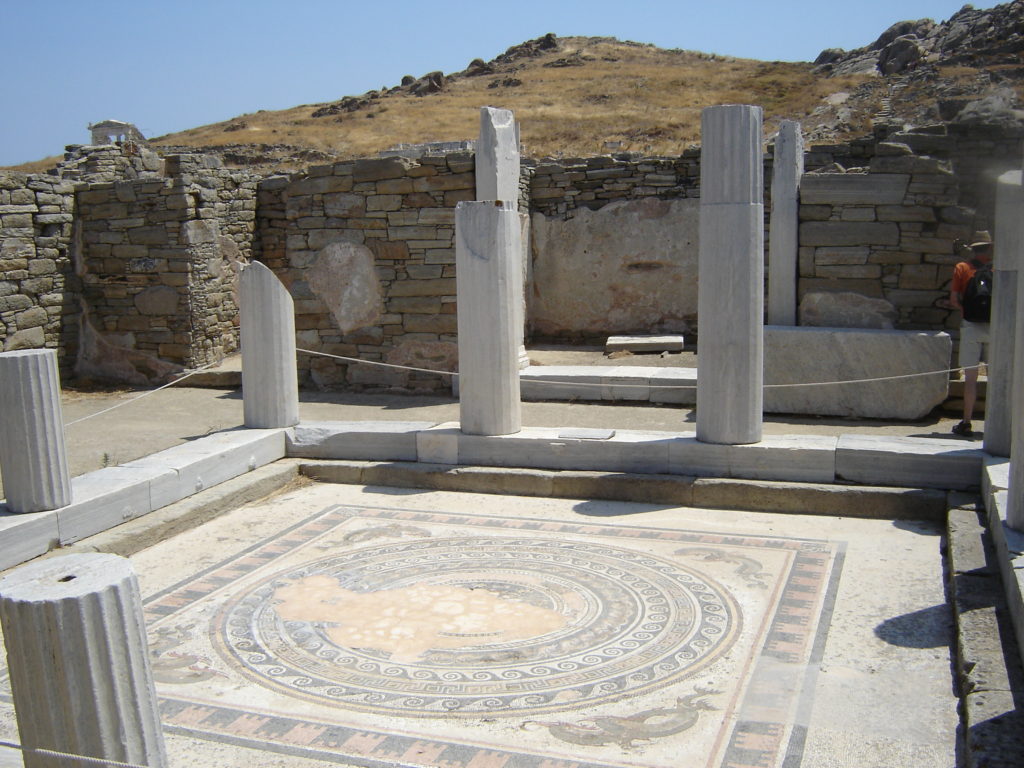
The House of the Dolphins
Delos has been occupied, as far as we know, since the third millennium B.C. As the midway point between the Greek mainland, the western Aegean islands, and the Ionian coast, it was the perfect stopping point for ship-bound traders.
However, the main reason for the popularity of Delos, for its sanctity, was that it was believed to be the birthplace of two of the most important gods of the Greek and Roman pantheons – Apollo and Artemis.
To reach Delos today you must take a boat from the nearby Cycladic island of Mykonos. It is a choppy ride and not for those without sea legs. The Cyclades are in a windy part of the Aegean. However, the short odyssey to get there is well worth it. Once you come out of the waves and into the Delos Strait between the island of Rhenea and Delos itself, the waters welcome the visitor and Delos appears like a hazy jewel in a brilliant turquoise sea.
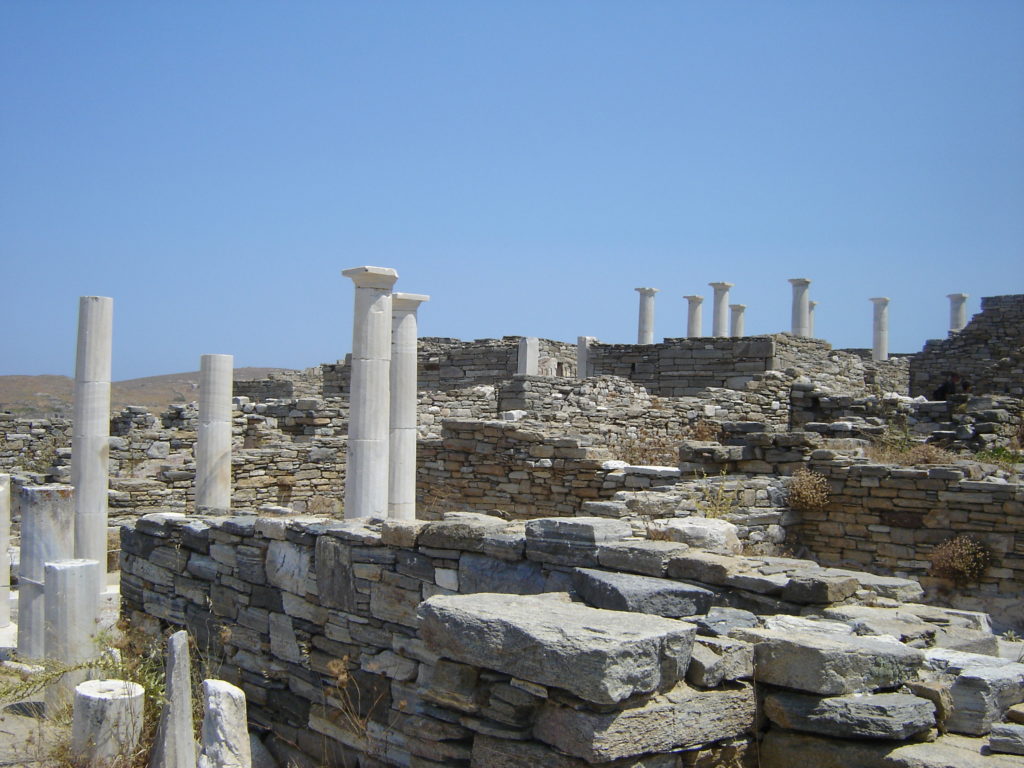
Part of the residential district of Delos
Delos is not just another archaeological site to be seen hurriedly through the lens of a camera. For those open to it, as soon as you set your foot on the path from the ancient ‘Commercial Harbour’ to the upper town, you know this place is different. This is a place to be felt with all your senses.
Apollo’s sun beats down with intense heat, and the hot Aegean winds wrap themselves about you at every turn. The voices of the past are loud indeed, be they of priests or pilgrims, merchants or charioteers, theatre patrons or performers, the rich or poor. Everyone came to Delos for all manner of reasons, for thousands of years.
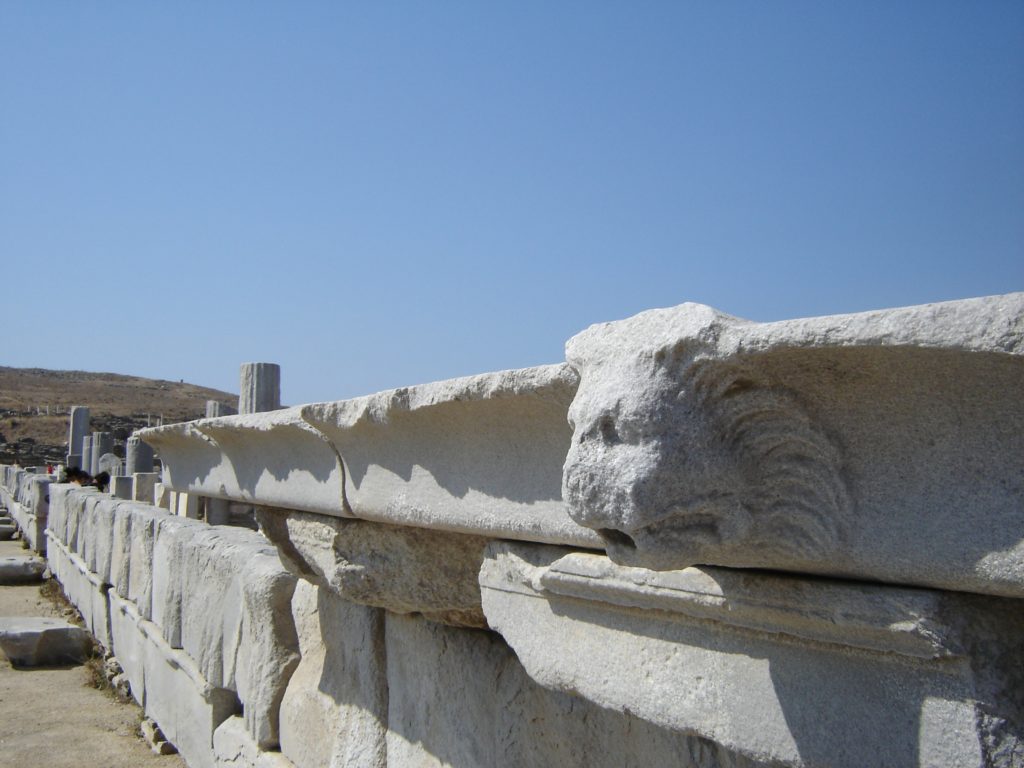
Ruins along the Sacred Way
To preserve the purity of the place in ancient times, it was forbidden for anyone to be born or to die on Delos. Those who were involved in either of these acts were sent across the strait to Rhenea to do so. As the birthplace of important gods, this was taken very seriously.

The Palm and the Sacred Lake
…the pains of birth seized Leto, and she longed to bring forth; so she cast her arms about a palm tree and kneeled on the soft meadow while the earth laughed for joy beneath. Then the child leaped forth to the light, and all the goddesses washed you purely and cleanly with sweet water, and swathed you in a white garment of fine texture, new-woven, and fastened a golden band about you. (Hymn to Delian Apollo)
The usual visitor might be led directly to the small museum on-site where several artefacts are on display. Others feel themselves pulled in the direction of the place that made Delos famous. The Sacred Lake, where Leto is said to have laboured for nine days when giving birth to Apollo and Artemis, is still there with its magnificent palm swaying in the sea breeze. The lake is drained now, and the palm is a distant ancestor of the original, but it is still a marvel to stand in a place revered for ages. On a nearby hill, the nine Delian lions stand guard over the birthplace of the gods, ever watchful.
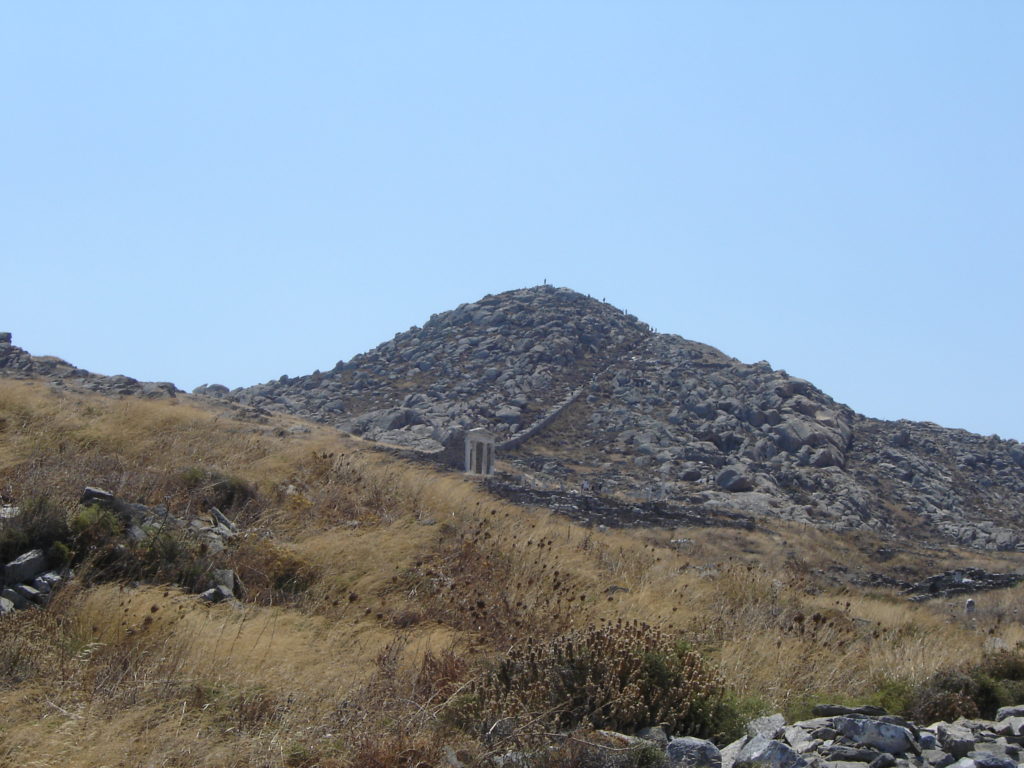
Mount Cynthus
Delos was not just a quiet place for religious reflection. Indeed, it was very busy and at one point had a population of about 25,000 people. It was covered with sanctuaries and temples, monumental gates and colossal statues, stoas, shops, homes, theatres, stadia and agora. And above it all was mount Cynthus, 112 meters high, where the Archaic Temple of Zeus looked down over the birthplace of his son and all the mortals coming to do them homage.
If you stroll about the island you will be greeted by something new around each corner; a different view of the sea, ancient homes with some of the most beautiful mosaics ever found open to the sky, the ruins of a once-beautiful theatre, or even something as simple as a stretch of marble paving slabs from whose cracks red, purple and yellow flowers sprout to paint the scene.
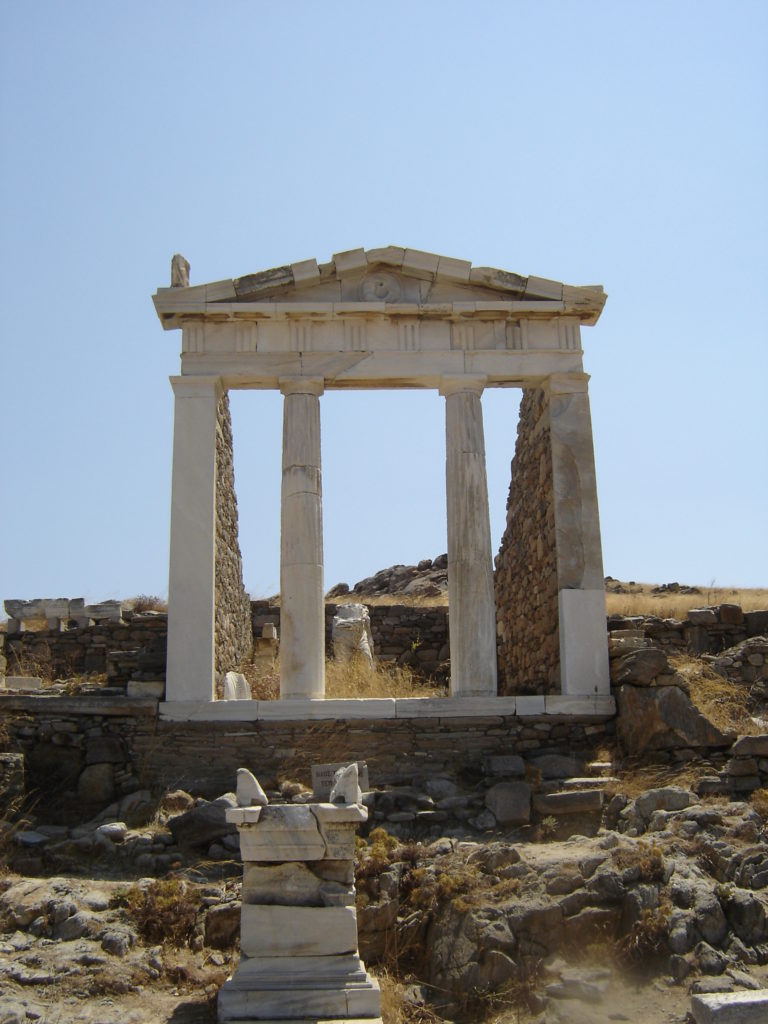
Temple of Isis in the Sanctuary of Egyptian Gods
Delos was a meeting place of many deities, not only Apollo and Artemis. There were also temples to Zeus, Athena, Poseidon, Hera and many others of the Greek Pantheon. On the Island of Delos there were also sanctuaries to Syrian, Egyptian and Phoenician deities. Near the stadium area, archaeologists have uncovered the remains of a Jewish Synagogue. All were welcome to make offerings, worship, work and trade on this tiny rock-of-an-island which, by the 1st century B.C., was one of the great commercial centres of the world.
As one walks around the site today, it is not necessarily the voices of trade and craftspeople at their daily work that one is reminded of.
The shops have long since closed their shutters and turned to dust. The treasuries have been looted, and subsequently crumbled. Grass and wild flowers sprout from between the paving slabs of the Sacred Way where asps warm themselves beneath the rays of Apollo’s light.
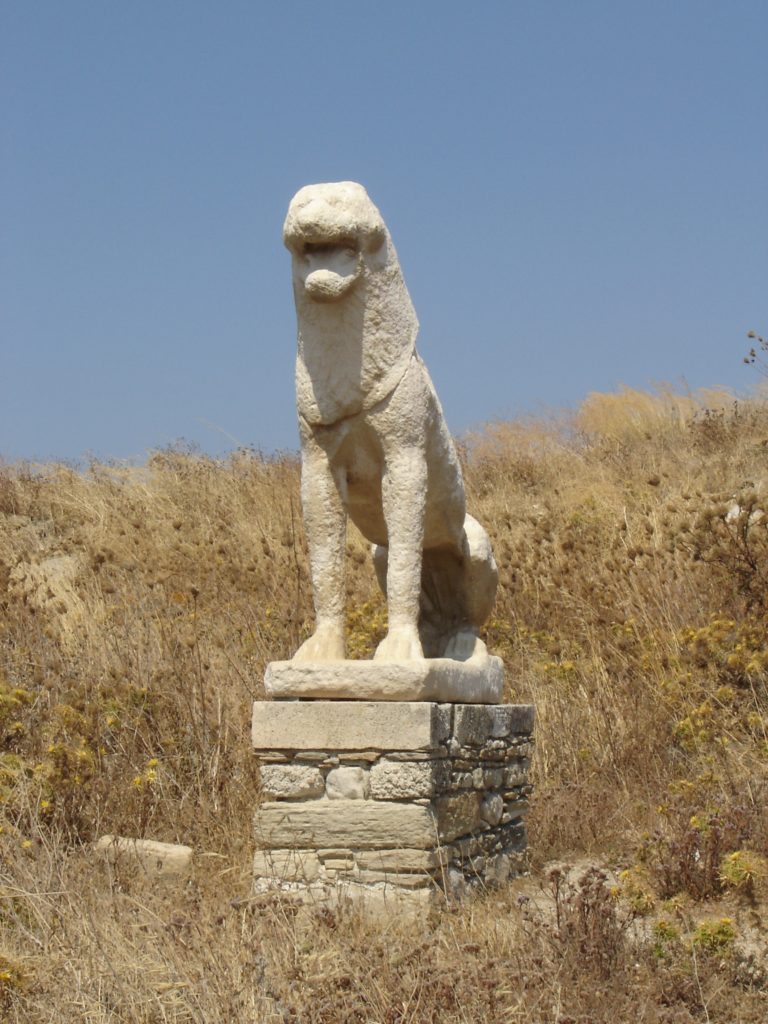
One of the Delian Lions overlooking the Sacred Lake
In truth, it’s difficult to describe in words the feeling one gets while cutting a meandering path among these ancient ruins. Delos is a place of light and colour and ancient beauty, an omphalos of the Aegean to which travellers have been drawn for ages.
For myself, there is an overwhelming sense of awe and absolute peace that creeps over me whenever I visit this place. It’s not always an easy task to shut out the groups of tourist hoards that descend upon this unassuming rock by the boatload. However, if you can manage the journey there, to break away from the masses, you will be treated to an experience in which you will delight in myriad shades of blue and pristine white, hot Aegean breezes and the loving light of the sun.
Most of all, you will stand still and wonder at the sight of a swaying palm, that one spot on the island where gods were said to have been born, and which earned this place called Delos renown for all time.
…queenly Leto set foot on Delos and uttered winged words and asked her… “Delos, if you would be willing to be the abode of my son “Phoebus Apollo and make him a rich temple –; for no other will touch you, as you will find: and I think you will never be rich in oxen and sheep, nor bear vintage nor yet produce plants abundantly. But if you have the temple of far-shooting Apollo, all men will bring you hecatombs and gather here, and incessant savour of rich sacrifice will always arise, and you will feed those who dwell in you from the hand of strangers…
(Hymn to Delian Apollo)
A picture is indeed worth a thousand words, so, if you would like to see more, just continue scrolling down to continue the visual Odyssey.
Thank you for reading…
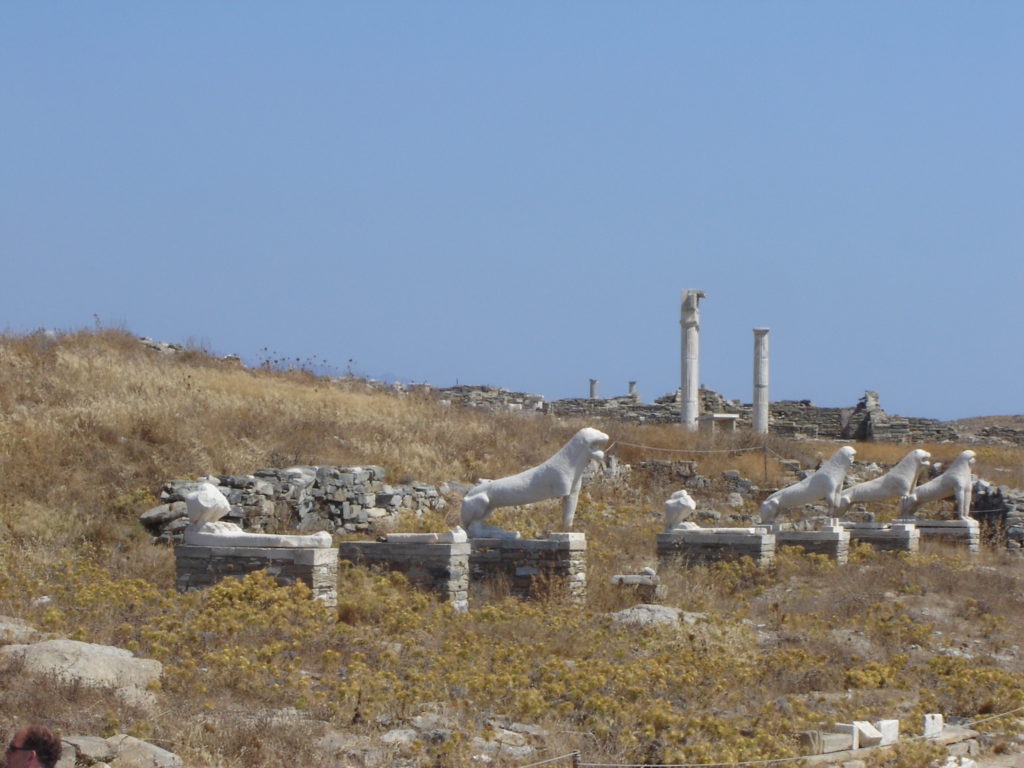
The nine Delian Lions keep a timeless watch over the Sacred Lake
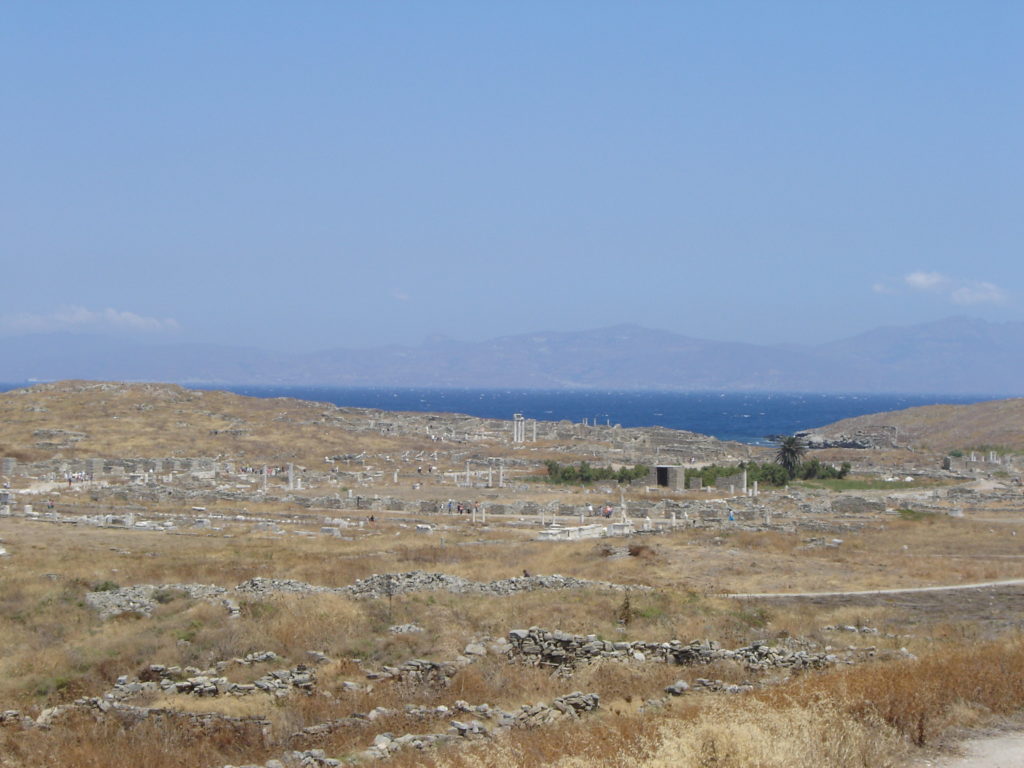
Part of the archeological site of Delos. Excavations continue as most of the island remains to be uncovered
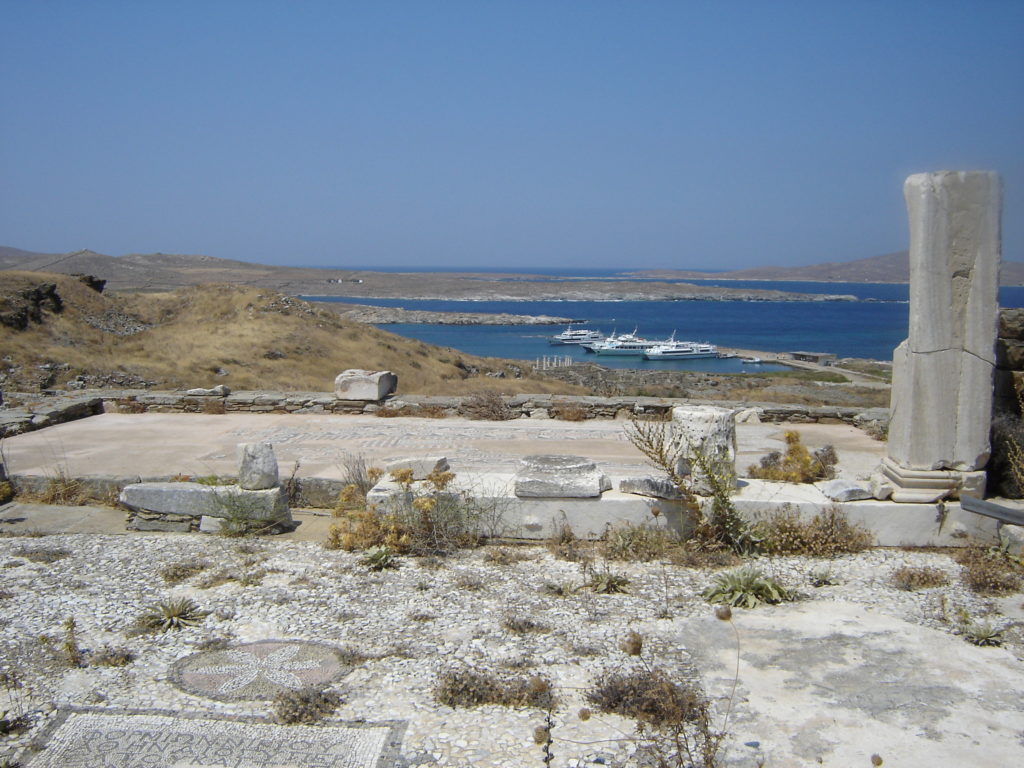
Terrace of a Delian house overlooking the Commercial Harbour
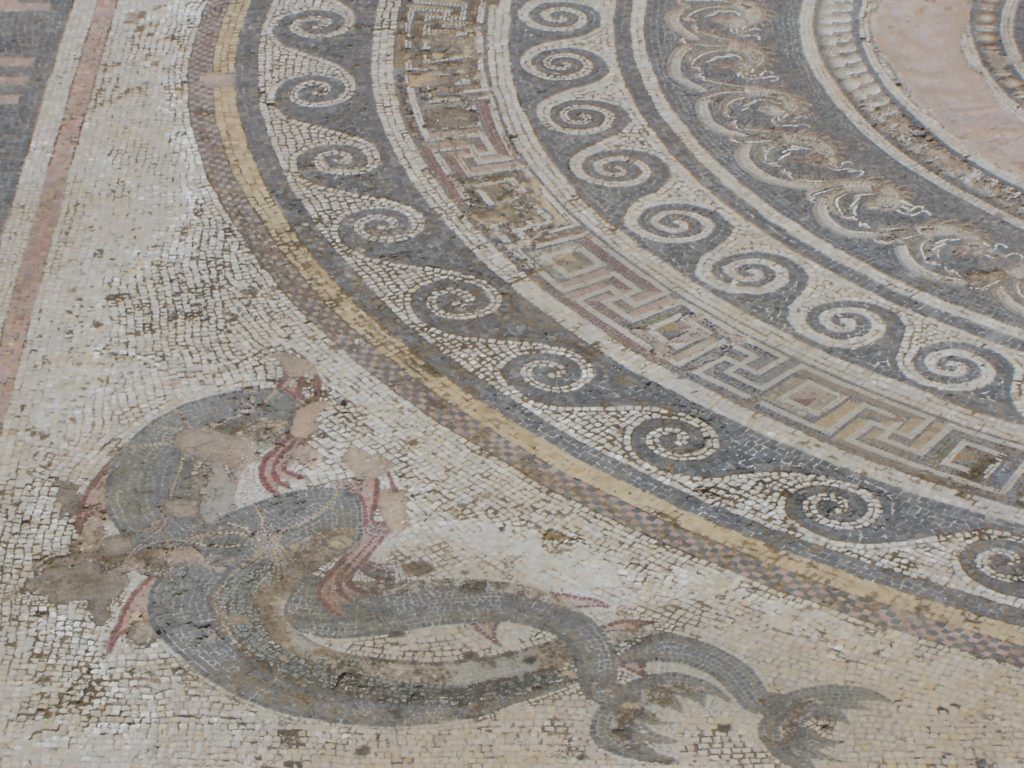
Mosaic at the House of the Dolphins
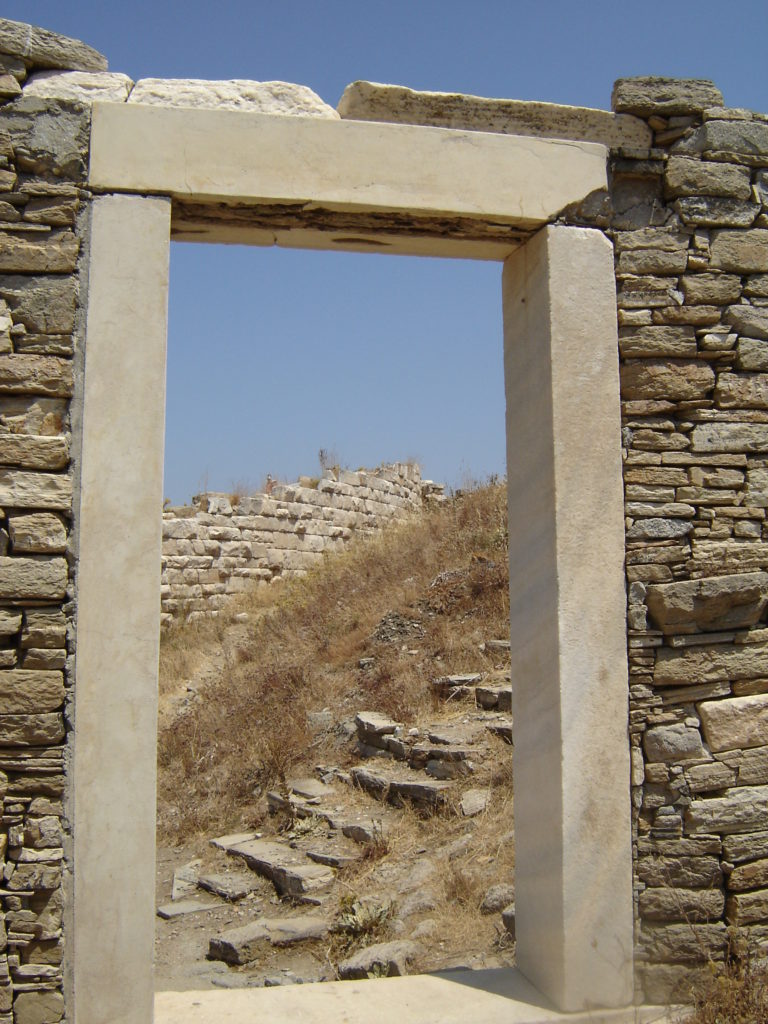
Doorway to the back of the theatre
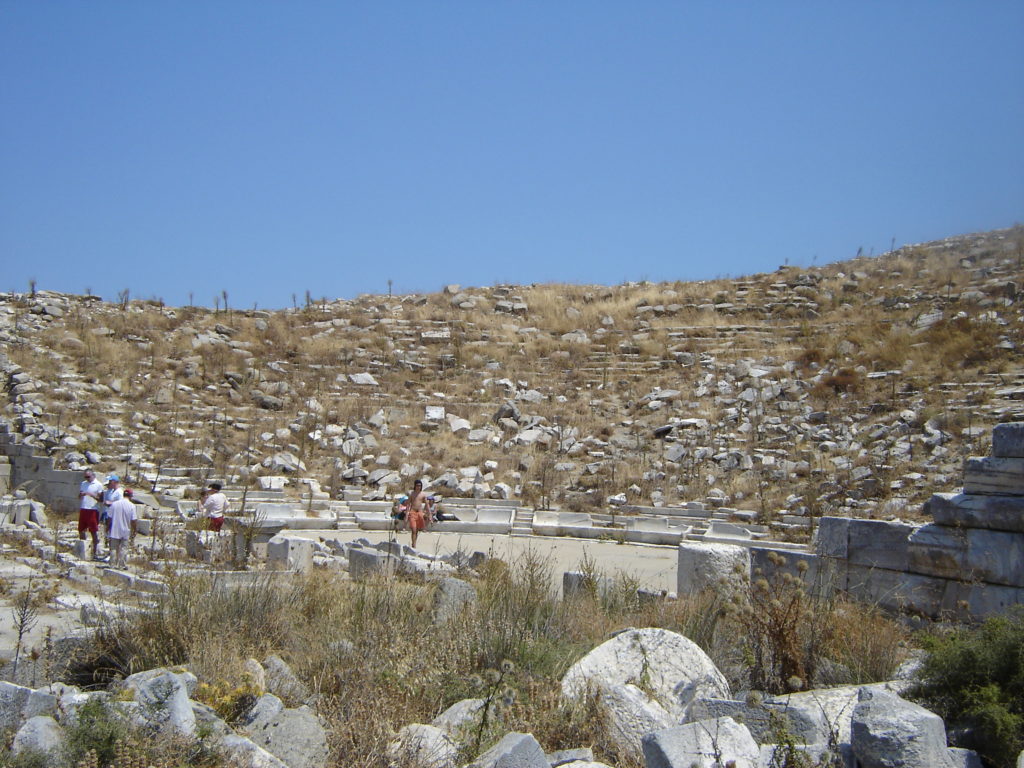
The ancient theatre of Delos. The artistic competitions of the ‘Delia’ were performed here
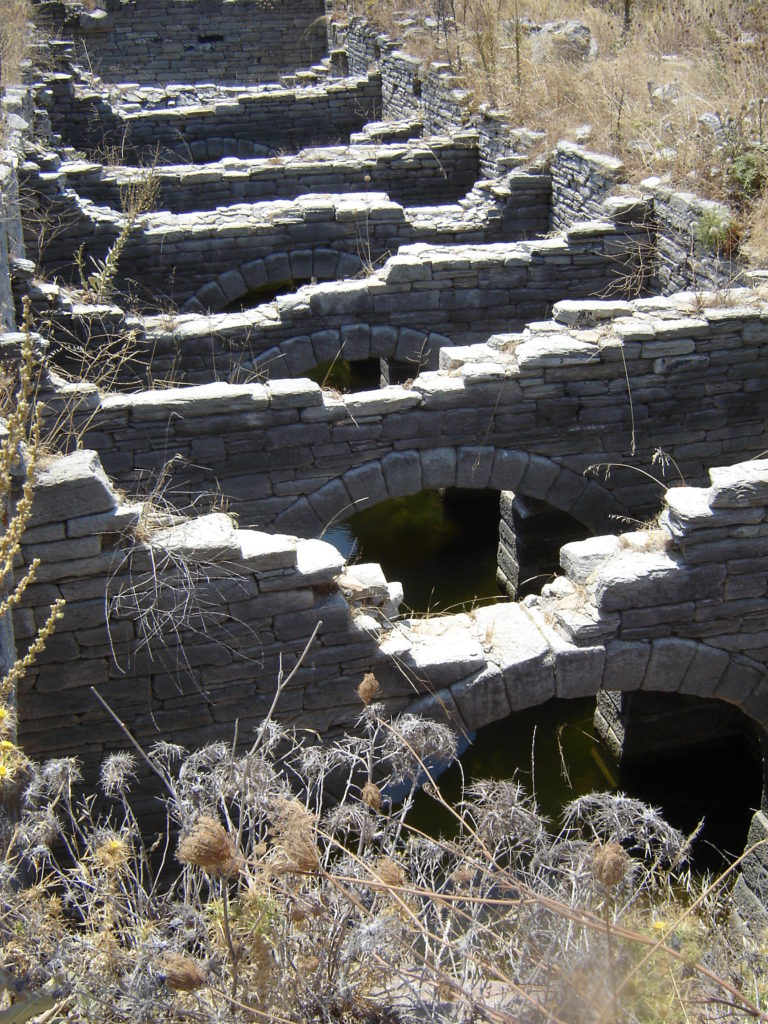
Island cisterns where rain water was gathered

Alleyway among the ruins of Delos

Mosaic in the residential quarter

Mosaic waves open to the sky
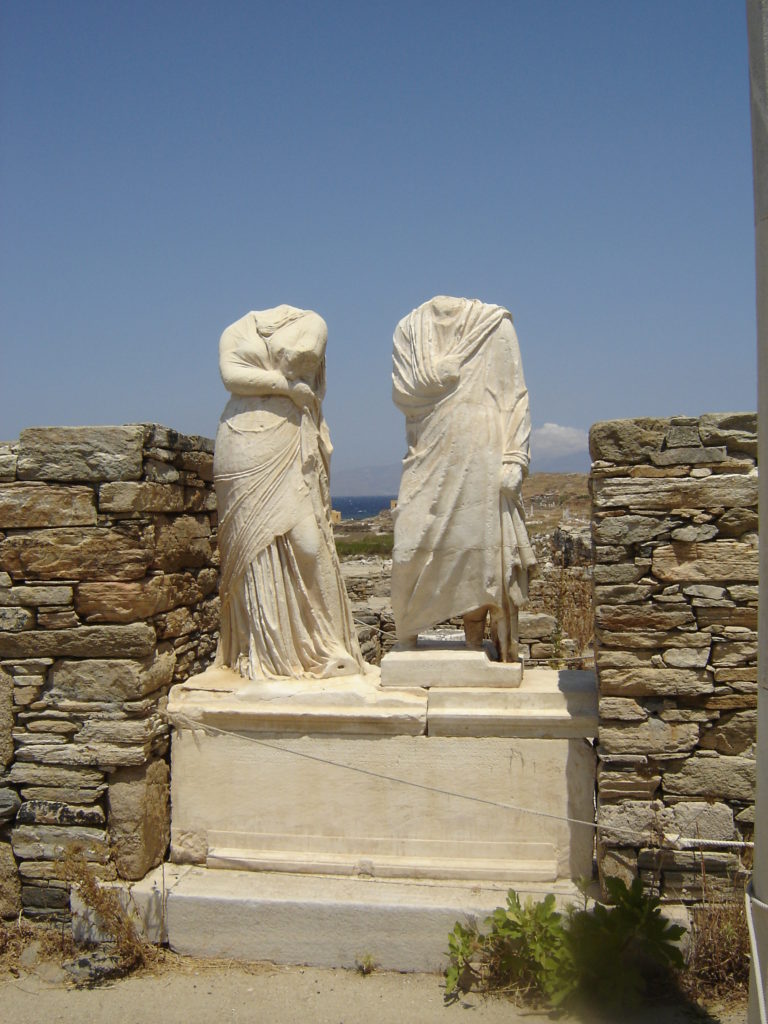
Statues in the House of Cleopatra
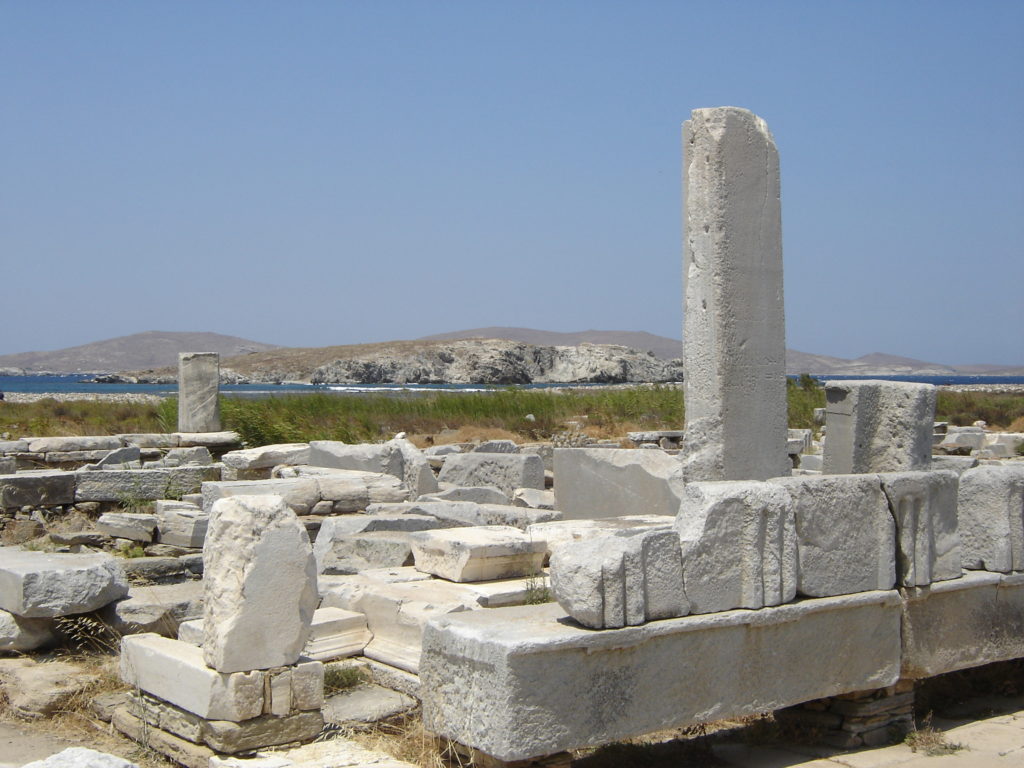
Ruins near the harbour

Remains of colossal statue of Apollo (the torso)

Artist rendering of ancient Delos – Francesco Comi, 1995
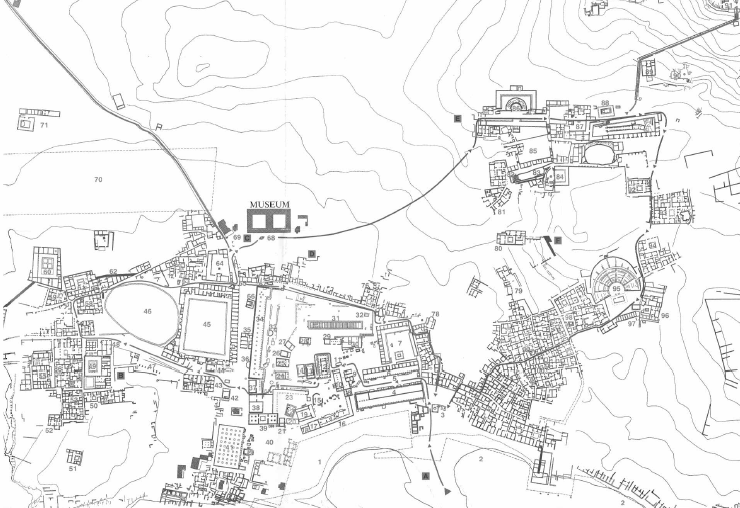
Map of the Archaeological site of Delos Edition sponsored by the Hellenic Republic, Ministry of Culture and the European Community (3rd CSF 2000-2006)
To Delos in another light, other than the parched, tourist-packed summer landscape we are familiar with, check out the beautifully shot video below, directed by Andonis Theocharis Kioukas. In this video, you see Delos in the fullness of spring, quiet, green, with myriad colours bursting from among the ruins.
https://www.youtube.com/watch?v=8nTyppBJVso
The World of Killing the Hydra – Part I – Leptis Magna: The Jewel of Roman North Africa
As with The World of Children of Apollo, this blog series will take a look at many of the people and places that the series protagonist, Lucius Metellus Anguis, encounters throughout his journey.
So, let’s step back in time to the early 3rd century A.D., and explore the first place Lucius comes to in Book II.
The ruins of Leptis Magna are located at what is now Khoms, a site by the Mediterranean Sea at the northwestern corner of Libya. As a Roman city and archaeological site, it is not really familiar to the average person. Mainly academics have studied it, and excavated its wealth of cultural treasures.

Aerial view of Leptis Magna
It was founded around 1000 B.C. by Berbers and Phoenicians. Later, Carthage held sway over the polis until that great civilization finally succumbed to the Roman war machine at the end of the Third Punic War in 146 B.C.
It was during the reign of Emperor Tiberius (A.D. 14-37) that the city was officially incorporated into the Empire’s province of Africa Proconsularis. In A.D. 110, the Emperor Trajan (c. A.D. 98-117) made Leptis Magna a colonia, an official settlement for retired men of the Legions and Roman citizens. From then on, the city experienced a period of growth and success, making it the third largest city of Roman North Africa after Carthage and Alexandria.
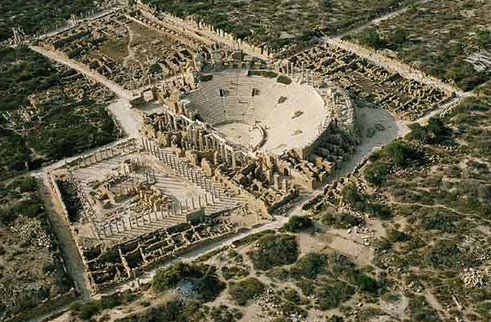
Theatre of Leptis Magna
It had a theatre that was built during the reign of Augustus (27 B.C. – A.D. 14), and one of the most flourishing North African markets of its day. In Leptis Magna, you could buy slaves, exotic animals, olive oil from the rich estates that surrounded the city, garum (Romans’ favourite fish sauce), salted fish, ivory, precious gems, spices, etc. etc. etc.
There was also a forum, the heart of every city, which had a curia, a basilica, a Temple of Liber Pater, a Temple of Hercules, and a Temple of Rome and Augustus.
Finally, what’s a Roman city without a bath complex? In A.D. 126, on his tour of the Empire, Emperor Hadrian had a huge bath complex with a palaestra (exercise field or hall) built for the city. It certainly seemed like the emperors paid attention to this hot, wind-kissed settlement on the south side of the Middle Sea.
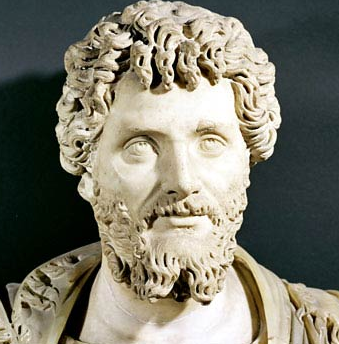
Emperor Septimius Severus
But the real heyday for Leptis Magna came when her own favoured son, Lucius Septimius Severus, became Emperor (A.D. 193-211). It was through this half-Punic (Carthaginian), and half-Roman ruler that the city truly felt the warmth of the sun on its face.
You can read more about the Severus and his family HERE.
Septimius Severus did what most rulers will do for their favourite cities – he gave it infrastructure, and he gave it beauty. Give a city these two things and it will attract population, trade, and the Empire’s attention.
Around A.D. 203 the imperial family and court descended on Leptis Magna; the Emperor had returned home and there were festivals, banquets, and the unveiling or dedication of monuments.

The Severan Basilica
The ruins that have been uncovered in Leptis Magna reveal an ancient city that was wealthy, efficient, and enjoying the good life.
Among the things that Severus built in Leptis Magna were a new harbour and docks, complete with a lighthouse, warehouses and a Temple of Jupiter. For a city involved heavily in trade, this was a big bonus.
Leading from the docks to the nymphaeum (a monument, spring, or fountain dedicated to the Nymphs), Severus ordered the building of a long colonnaded street that was sixty-five feet wide.

Gorgon head from the Forum of Leptis Magna
He added many new public buildings too, including a large basilica which was decorated with red granite columns with white marble capitals. And even though Leptis Magna already possessed a forum, Severus built a new one that was graced with the enormous Medusa heads that remain to this day.
One of the most interesting pieces of new architecture that appeared in the city during Severus’ reign was the four-sided Arch of Severus. Its design was something new, the friezes and political and religious scenes displaying an artistic style that had not been seen before.
It must have felt like a true ‘Golden Age’ to the citizens of Leptis Magna.

The four-sided arch of Severus at Leptis Magna
You can imagine the palpable excitement among the people in the streets as the Emperor, Empress and their sons disembarked from their ship in the harbour and processed to their palace. The entourage would have been enormous, as well as the force of Praetorians who would have followed the Emperor. After all, Gaius Fulvius Plautianus, Prefect of the Praetorian Guard, was also a son of Leptis Magna.
It is in the midst of all this excitement, among all these powerful and wealthy people, that Lucius Metellus Anguis’ journey in Killing the Hydra begins.
There is a lot going on in the world, and many dangers lurking in the shadows about Lucius.
He will have to tread very carefully indeed…
Thank you for reading!
In the meantime, here are a few more stunning photos of the magnificent artwork discovered at Leptis Magna:

Libyan and Italian archaeologists uncover chariot race mosaic at Roman villa (National Geographic)
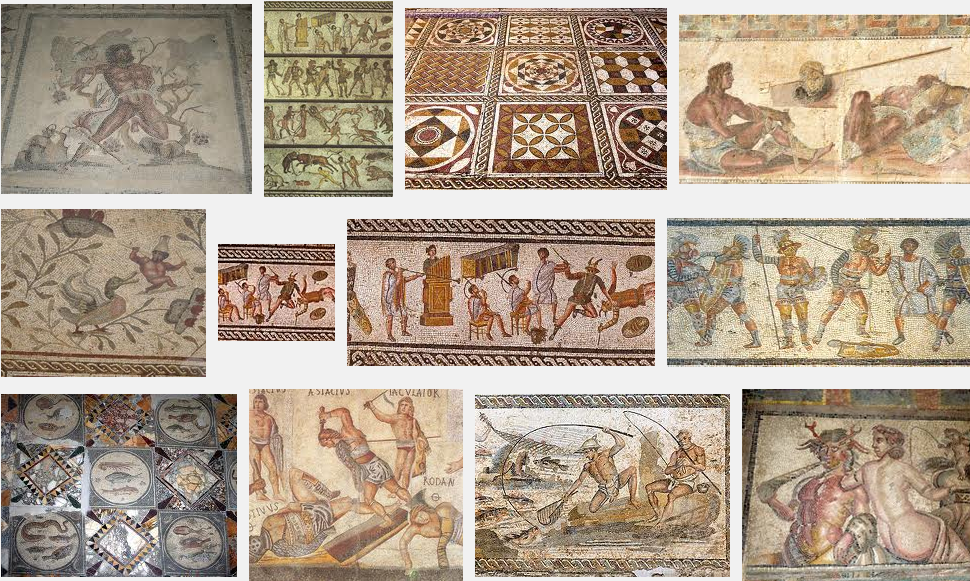
An magnificent array of more Leptis Magna mosaics
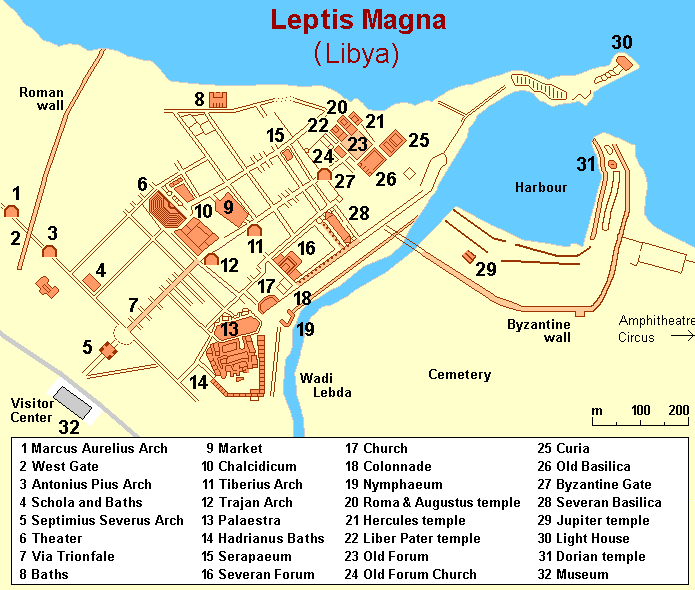
Site map of Leptis Magna (Wikimedia Commons)

